








• We uphold a Fiduciary Standard and work with clients on a fee-only basis.
• We do not receive commissions, kick-backs, or soft dollars from product sales, eliminating inherent conflicts of interest.
• Our team of professionals holds designations and degrees such as CFP®, CFA, CPA, MBA, and PhD.
• Charles received his MBA from the Kellogg School of Management - Northwestern University, his MA in Economics from WMU, and Executive Education from Harvard Business School and Columbia University. Charles Zhang, CFP®, MBA, MSFS, ChFC
• Ranked #1 on Barron’s list of America’s TOP Independent Advisors and is the highest ranked NAPFA-Registered Fee-Only Advisor on the list.*
• Ranked #4 in the nation on Forbes’ list of TOP Wealth Advisors and is the ONLY Independent Advisor in the top 10.**
investment: $1,000,000 in Michigan/$2,000,000 outside of Michigan.
under custody of LPL Financial, TD Ameritrade, and Charles Schwab.
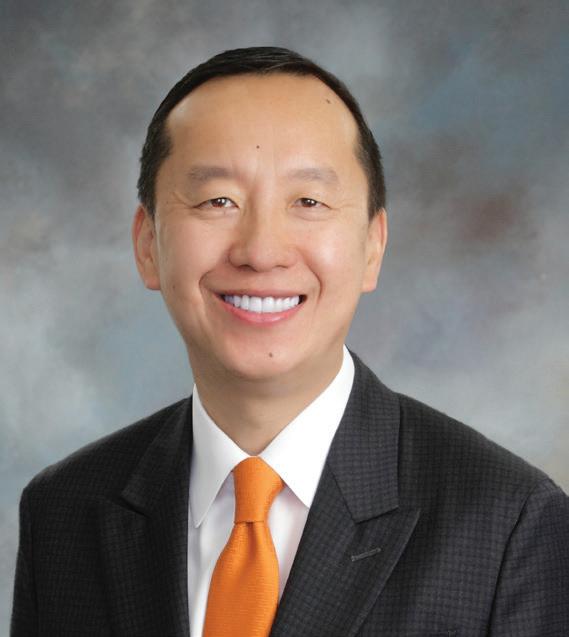
NET NOW PART OF THRIVE Safety Net , an IT services firm with offices in Traverse City and Detroit, has been acquired by Thrive, a global technology outsourcing provider for cybersecurity, cloud and IT managed services. With the acquisition, Thrive expands its reach to the Midwest, enabling Safety Net’s existing and new customers to have access to Thrive’s global security operation center and hybrid cloud solutions. “With over two decades of providing strategic IT solutions to Michigan businesses, our team is excited to accept the challenge of accelerating our growth to become the premier managed services provider in the Midwest,” said Tim Cerny, CEO of Safety Net.
Traverse Connect, Munson Healthcare, DroneUp, blueflite, and Central Michigan University’s Rural Health Equity Institute have announced plans for an upcoming aerial medical delivery project. The project will consist of test flights to deliver medical supplies between Munson Healthcare facilities in Traverse City, Garfield Township and East Bay Township. Test flights will be conducted between November 2024 and May 2025. This is the first uncrewed medical delivery project in the Grand Traverse region and the first funded by the State of Michigan.

The Bay Area Transportation Authority (BATA) has received a $795,673 grant from the Michigan Public Service Commission (MPSC) to install more than 650 solar panels on the roof of BATA’s new 80,000 square-foot headquarters at the corner of LaFranier and Hammond roads in Traverse City. BATA was one of 19 different projects selected out of 52 applications. Benefits of the solar project include 650 rooftop solar modules that will offset nearly all the facility’s daily electrical usage; $63,000 in annual estimated recurring electrical utility savings; 260 tons of estimated carbon dioxide and one ton of sulfur dioxide removed from Michigan’s air, land and water. The installation is planned for next spring.

NEXT STEP FOR PASSENGER RAIL
Groundwork Center for Resilient Communities has hired engineering and professional services firm WSP to serve as the rail consultant for the “Phase II study” for the proposed Michigan North-South Passenger Rail Project. Groundwork and its partner, the Cadillac/Wexford Transit Authority, will now work alongside WSP to establish a roadmap for how project players can move forward with fixing the railways, establishing passenger rail stations, and ultimately getting rail service up and running.


A $5 million-plus expansion is underway at Traverse City’s Historic Barns Park at the Grand Traverse Commons, with the now-vacant Barn 206 to be transformed into a new Botanic Garden education center. The adjacent Cathedral Barn improvements, a new two-story connecting tower that will join the two barns with common lobbies and universal elevator access, and water infrastructure upgrades are also planned for the property. Architect Ray Kendra of Environment Architects and construction contractor Eckler Building Solutions are overseeing the renovation project, with the barn’s upper level to become the Botanic Garden’s new Debra J. Edson Family Education Center. The center will feature classroom and event space, a demonstration teaching kitchen, a gallery, and office space.
In observation of Veterans Day, the Grand Traverse-Leelanau-Antrim Bar Association is offering free wills and durable powers of attorney for estate planning to veterans on Thursday, Nov. 11, 12pm4pm at the Traverse Area District Library.




















Services will be provided free of charge to any veteran by volunteer licensed attorneys from the local area. No registration required, but an RSVP is appreciated by emailing admin@gtlaba.org. Bring a valid ID and proof of military service.

The Festival Foundation – which manages events including the National Cherry Festival, Iceman Cometh Challenge, Cherry-T Ball Drop, and the Leapin’ Leprechaun 5K Race – recently appointed its 2024/’25 board of directors: Max Anderson, president; Kelli Mengebier, president-elect; Mike Meindertsma, immediate past president; Ian Hollands, treasurer; and Nikki Schweitzer, secretary. The Foundation also welcomed new board member Peg Jonkhoff.

Interlochen Public Radio’s “Points North” podcast recently won a national Edward R. Murrow award from the Radio Television Digital News Association. The podcast was honored in the Excellence in Diversity, Equity and Inclusion category for the episode “Complete With His Language: Kenny Pheasant and the Great Lakes’ Original Tongue.” Executive producer and host Dan Wanschura accepted the award at the Edward R. Murrow Awards Gala last month at Gotham Hall in New York City.
The Grand Traverse Regional Community Foundation’s Anchor and Heart Endowment has awarded a $110,325 grant to Munson Healthcare Paul Oliver Memorial Hospital, supporting the Paul Oliver Living and Rehabilitation Center (POLAR). As a long-term care community located within the hospital, POLAR aims to promote a sense of peace and healing and cultivates independence and social, emotional, and mental well-being of its
long-term residents. The Anchor and Heart Endowment grant will be used to support POLAR’s mission, allowing for the purchase of a long-term care resident transport van, long-term care mattresses, and parallel bars for therapy.

Traverse City Light & Power recently opened its second customer service center at 130 Hall St. in downtown Traverse City. “As we continue to enhance our services, we’re excited to open our new customer service center on Hall Street,” said TCLP Executive Director Brandie Ekren. “This new location underscores our ongoing commitment to making it easier for our customers to connect with us and access the reliable service they expect.” The new location is open from 8am-4:30pm, Monday through Friday. Customers can also continue to visit the 1131 Hastings St. location during the same hours.
Impact100 Traverse City recently announced the three area nonprofits that will share $348,000 in grants. The Northwestern Michigan College Foundation, Thompsonville Area Revitalization Proj ect, and Friendship Community Center were each awarded $116,000 after being selected by membership rank vote. The NMC Foundation will use the funding to purchase a 3D printing arm. This 3D printer will revolutionize the construc tion industry in our region by leveraging cutting-edge technologies to construct homes, while also helping students acquire specialized technical skills that will set them apart in the job market. Thompson ville Area Revitalization Project will utilize the grant to construct its keystone project – a bicycle trailhead and an ADA com pliant visitor’s pavilion and campground. And Friendship Community Center hosts Leelanau Investing For Teens (LIFT), a no-cost, out-of-school program for 6th-12th graders in Leelanau County that connects teens with community mentors and offers activities that support their development and mental health. LIFT will utilize the funding to update its classrooms and pur chase a 12-passenger vehicle.


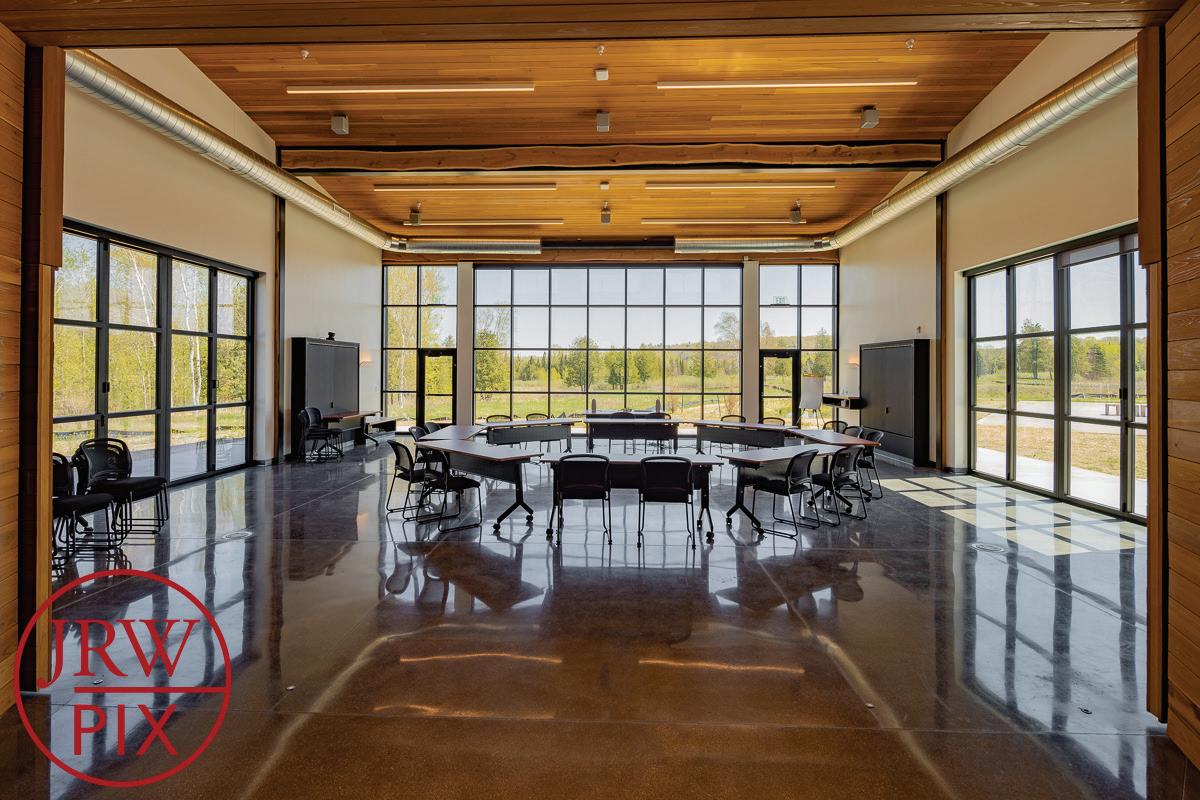




Rain, shine, wind or snow, count on us to help you reach your goals.
Our Demand Response Program rewards businesses for shifting when they use energy. In 2023, participants earned over $7.3 million in incentives to reinvest in their operations, just for the summer. Beginning in summer 2025, Demand Response will be available year-round, with incentives paid at the end of each season. That means more opportunities to boost reliability — and your bottom line.
There’s no better season than now to be part of something bigger for your business and Michigan. Space is limited. Scan the QR code or go to ConsumersEnergy.com/goals today to learn more and enroll for summer 2025 and beyond.

Between the imminent holiday parties, buying presents, decorating, and various other activities, one can get lost in how busy this time of year feels.
At the same time, there are a lot of people and organizations in our community that need our support. For many years, serving on the Advancement Committee of Father Fred, I saw firsthand the needs in our community as staff and volunteers worked tirelessly to make sure families had food on their tables and young kids had warm clothes, especially going into the cold winter months.
Currently serving as the board president of Traverse City Philharmonic and board member of TC Tritons rowing, I have seen the needs of these organizations. At TC Phil, as we playfully say to our friends, we are growing into our new music school where no child will be turned away due to financial constraints.
At the TC Tritons, we provide amazing opportunities for middle and high school students to learn the importance of teamwork and dedication through rowing. Many students additionally receive scholarships that allow them to further their journey after high school. There are so many great local organizations, and they rely on us in one way or another for support.
One thing I have found is that no matter how busy I am, or what other things
I am working through, time invested helping other people and organizations always leaves me feeling uplifted, even on the busiest of days. At the same time, I learn and grow through the process. In talking to others this past year, many have said that they just don’t have time to get involved: “Maybe one day when I retire,” or “Maybe when I reach a certain financial level.” We all have varying degrees of time and resources, many even less than me, but one thing I always reply is that often there are
include in shopping bags to customers to raise awareness. Both ideas are low-time and low-cost, and we hope they can make a small difference and be a win-win.
I have friends who organize golf outings. Not only is this a great win for the charities they sponsor, it also helps them meet new people and show how much they care about our community, all while doing something they love. I personally have enjoyed serving on boards as I learn a lot and get to meet many interesting people. While this can potentially be a
We all have varying degrees of time and resources, but often there are creative ways to help, no matter what the circumstance.
creative ways to help, no matter what the circumstance.
What are some good solutions to help our community even if you are still getting established, investing in a business, or busy with family? Perhaps find ways to partner with organizations.
For example, at Blue Goat Wine & Provisions we are trying something new this fall: We are purchasing TC Philharmonic tickets up front to use in holiday gift baskets. Also, we are handing out flyers with upcoming concerts that we can
EDITORIAL
tcbusinessnews.com
PUBLISHER
Luke W. Haase
lhaase@tcbusinessnews.com
CONTRIBUTING EDITOR
Gayle Neu
gneu@tcbusinessnews.com
HEAD WRITER
Craig Manning
STAFF WRITER
Art Bukowski
CREATIVE DIRECTOR
Kyra Cross Poehlman
CONTRIBUTING WRITERS
Ross Boissoneau Kierstin Gunsberg Rick Haglund
COPY EDITOR Becky Kalajian
WEB PRODUCTION: Byte Productions
MAILING/FULFILLMENT Village Press
DISTRIBUTION Gerald Morris
SERVING:
Grand Traverse, Kalkaska, Leelanau and Benzie counties
bit more of a time commitment, the right organizations value their volunteers and board members and are very respectful to leverage their skills and knowledge as best as possible.
I sat down with Executive Director Dr. Kedrik Merwin of the Traverse City Philharmonic for some ideas, and he mentioned how even small gifts of $100 or less provide students with scholarships for music lessons. He said some people also sponsor instruments for students, because even if we provide the lessons, they still
need an instrument of their own to play.
On the other hand, other individuals offer rides to a lesson instead of a monetary donation, giving just a little bit of their time to help others in need. At TC Tritons, volunteers help us coach our kids, get meals lined up, and help put workout programs together. Most nonprofits have a lot of things they can use help with – filling envelopes, running quick errands and such – so it’s relatively easy to find an organization whose needs align with something you already enjoy doing. If we all came together to do some of these little things, the cumulative effect would be gigantic.
I hope everyone has a wonderful holiday season and feels the love of all of those around them. Let’s see what good we can do in our amazing community during a time where we often get busy otherwise. Cheers!
Sebastian Garbsch founded Formative Fitness after graduating from Ferris State University with his bachelor’s in business. He is the owner of Blue Goat Wine & Provisions and is currently serving as president of the Traverse City Philharmonic, as well as on the board of TC Tritons Rowing and Downtown Traverse City Association. In his free time, he enjoys spending time with his family, being outdoors and seeking new opportunities that align with his passion for business growth and community engagement.
AD SALES
Caroline Bloemer cbloemer@tcbusinessnews.com
Lisa Gillespie lisa@northernexpress.com
Abby Walton Porter aporter@northernexpress.com
Kaitlyn Nance knance@northernexpress.com
Todd Norris tnorris@tcbusinessnews.com
Michele Young myoung@tcbusinessnews.com
POSTMASTER: Send address changes to The Traverse City Business News, PO Box 1810, Traverse City, MI 49685-1810. The Traverse City Business News is not responsible for unsolicited contributions.
©2024 Eyes Only Media,
By Art Bukowski
Brandie Ekren is the executive director of Traverse City Light & Power, a post she assumed in March of 2022 after spending 18 years in various roles at the Lansing Board of Water & Light. The Detroit native and Michigan State University graduate is thrilled to be “Up North,” and was glad to show the TCBN around her workspace. If you have an idea for a future From the Desk Of feature, please email Art Bukowski at abukowski@tcbusinessnews.com.


1. I’ve been into Legos probably since I was a kid, and now my sons have really been into Legos. I love planting and gardening, and I recently got turned on to these Lego plants. One of my employees gave me this Lego orchid for Christmas.
2. I am a chronic reader. I love books, I love leadership books, anything that’s about self-improvement or growing as a person. I absolutely love Brené Brown, who is all about resilience and leading with vulnerability, and how that’s actually a strength.
3. This little sign says ‘Trust in the Lord.’ My faith is really important to me. And when I say my faith, it’s more than just religion. I’m a Catholic, but I’d like to say I’m probably a little bit more spiritual than I am religious, and I take my faith and spirituality everywhere with me.
4. We just updated our strategic plan, which is very exciting to me. We’ve refreshed our mission, we did our vision, our values, established new priorities. And it’s all about leading with positivity and being powered by positive energy.
5. I’ve been a Kiwanis member since I was in Lansing. I joined in 2009, probably. I was the
president of that club and was on the endowment board. And then when I got offered the job to come to Traverse City, the local Kiwanis club here reached out to me and invited me to join. The local club is celebrating 100 years this year.
6. This is a calendar called Good Vibes. In essence, it’s daily motivations or affirmations. Today’s is: ‘Success and happiness are side effects of your daily rituals. They’re a natural result of moment to moment decisions.’ It just gives me something to think about.
7. These are called Team Tactics and Workshop Tactics. Obviously, energy and meetings are not the most exciting thing for everybody. So, I try to get all the help I can. These cards guide you through whatever it is that you’re trying to work through in an entertaining and engaging way.
8. I grew up in the inner city of Detroit. And in most of our neighborhoods, you don’t have a lot of forestry or plants. My grandmother was heavily into gardening within the house and within the backyard. Whenever you went into her home or in the backyard, it was comforting. It was like you went into a mini forest, and it was so tranquil. So plants have been my comfort my whole life.











By Art Bukowski
Dr. Tom Schermerhorn wants to be the voice of his fellow soldiers in the halls of leadership.
While he does indeed have a military background, the soldiers in this instance aren’t wearing combat uniforms. They’re in scrubs and face masks. They’re wearing stethoscopes or pushing gurneys. They are the men and women at Munson Medical Center who care for patients week in and week out.
Many things pile up on the plate of Munson’s chief medical officer (Schermerhorn assumed the role in August, replacing retiring Dr. Walt Noble), but Schermerhorn won’t soon waver in his desire to advocate for those out there on the front lines.
“I serve between the Munson administration and Munson medical staff, hopefully to communicate the interests and needs of that staff – not just their
neurosurgeon and is surgical director for Munson Neurosciences. This and his previous decades of experience mean he knows all too well the challenges faced by
“Medicine is hard. Healthcare is a difficult career to be in, and there are days that are physically, emotionally or intellectually demanding that push you to your edge in any one or all three of those realms. I want to serve my colleagues and partners and help them accomplish goals and elimi- nate the barriers and difficulties they’re experiencing.”
– Dr. Tom Schermerhorn, Chief Medical Officer, Munson Medical Center
daily needs, but their strategic interests,” he said.
Schermerhorn, 56, is still “elbow-to-elbow” with his colleagues as a practicing
those in his line of work.
“Medicine is hard. Healthcare is a difficult career to be in, and there are days that are physically, emotionally or
intellectually demanding that push you to your edge in any one or all three of those realms,” he said. “I want to serve my colleagues and partners and help them accomplish goals and eliminate the barriers and difficulties they’re experiencing.”
Schermerhorn is a Kalamazoo native who went to the United States Military Academy (commonly referred to as West Point) right out of high school, intending to head to medical school in short order.
“I was dissuaded by some of the folks I met along that process,” he said. “They said, ‘If you really think a medical career is the route you want to go, West Point’s probably not the right path for you. We send 2% of each graduating class on to

medical school, but that’s not our goal –our goal is to graduate combat leaders.’”
He bucked the trend and did end up in medical school, but only after he “drank the Kool-Aid” and dove head first into U.S. Army service. He was stationed in Europe and served as a platoon leader before heading to medical school after his honorable discharge.
To this day, he draws on the themes and values instilled during his military service. Things like paying attention to details, leading by example and putting nothing above the mission.
“Military service is a servant role. You’re subjugating your own interest for the good of the team, the betterment of the team,” he said. “And medicine is also the ultimate team sport. You put your patients’ interests ahead of your own, and as you evolve into other positions, especially leadership positions, it’s your patients’ interests and those of your team.”
He also sees a lot of similarities between the small-unit leadership he experienced as a platoon leader and now as a respected neurosurgeon.
“When I’m in the operating room, I may have an assistant across from me, a co-surgeon who’s been to medical school and is highly trained. And then I’ll have a nurse in the room, surgical technician, and anesthesiologist,” he said. “But we’ll also have entry-level folks: technicians and aides. So it’s a true team that’s assembled; each person critical to the outcome of that patient.”
After the Army, he went on to Wayne State University for medical school, then to the prestigious Mayo Clinic in Minnesota for his residency and a stop at Wake Forest for a spine fellowship. He also recently obtained a master’s in Healthcare Delivery Service from Dartmouth College.
“I loved my time at Wayne State. It was perfect for somebody that was a little bit older, like I was, because it wasn’t sitting in a classroom. We were in the wards, we were contributing to patient care and patient outcomes,” he said. “It was very hands-on and really a great place to train.”
Schermerhorn arrived at Munson
in 2003 and has been there ever since, raising three children in Traverse City and providing care (surgical or otherwise) for hundreds of patients over the years.
All systems go
Schermerhorn has been closely involved in several initiatives that have ramped up Munson’s care in recent years, including work to establish the hospital as northern Michigan’s only comprehensive stroke center.
Among the goals of that program was enabling local patients to stay in Traverse City for high-level care instead of seeking it out downstate. As CMO, Schermerhorn wants to push the envelope with this line of thinking.
“Our goal is to be able to provide the right care at the right place so that folks don’t have to leave home,” Schermerhorn said. “Considering the impact we were able to make with the growth of the neuroscience program, I want to have that same impact in the growth of other programs and the growth of our health system.”
While he’s all about supporting patients and coworkers, Schermerhorn’s new role will undoubtedly see him tugged in different directions as pressure from inflation, staffing and other business concerns have led to struggles for both patients and providers.
“We try to avoid thinking of medicine as a business, but there are bottom-line interests that we need to keep in mind,” he said. “We have no mission without a margin, so we need to act in a way that still puts the patients’ and our colleagues’ interests first while still being a good steward of our resources and delivering the best care in the most efficient manner.”
While they have enough to cover baseline staffing needs, Munson still needs to hire hundreds of people. Schermerhorn tips his hat to existing employees who have been grinding it out over the past five or so years in unprecedented times. This “particularly dedicated workforce” has been prepared for any challenges ahead, he believes.

“We went from pandemic right into a staffing or workforce crisis, and just as we started to emerge from the staffing crisis, now we have some financial constraints (with rising costs),” he said. “It’s been a trying time, but we were bumped and bruised and accumulated scar tissue in each of those events, and we’ve demonstrated resiliency and grit.”
Munson Healthcare is an independent nonprofit, and for years some people have wondered about its ability to remain independent in a sea of mergers and acquisitions. For his part, Schermerhorn isn’t worried about Munson getting swallowed up. He points to MHC’s regionalization efforts and expansions as evidence of a healthy system.
“I don’t feel like we’re vulnerable,” he said. “We’re doing good things financially…and we have significant plans for additional projects we plan to undertake.”
He’s also aware of (but not overly threatened by) independent radiology centers like Novello Imaging that are nipping at Munson’s heels from a business standpoint.
“Competition’s a good thing. Competition keeps us sharp on our game,” he said. “If we’re not delivering the most efficient, cost-effective care, then somebody’s going to come in and try to do that. So this will keep us focused.”

‘WE’VE
Supreme Court deals a blow to agencies that regulate health care, finance and more

By Rick Haglund
For the past 40 years federal agencies, including the Food and Drug Administration, the Environmental Protection Agency and dozens of others, have exercised broad powers in regulating most industries providing goods and services to consumers.
Consumer advocates say the work of these agencies has been critical in protecting the nation’s food supply, the environment, the financial system and consumer safety. Businesses, however, have long complained the rules have become increasingly onerous, amounting to government overreach.
But a landmark U.S. Supreme Court ruling in June dealt a severe blow to the agencies’ regulatory power, establishing that courts no longer must defer to federal agencies in interpreting ambiguous laws.
Local attorneys and business leaders say it’s too early to gauge the impact of the ruling but say it will likely be significant with positive and negative implications.
“We’ve been watching that case very closely,” said John Lynch, a Traverse City business law attorney who specializes in representing business startups. “It’s going to be very interesting as it impacts almost every facet of executive and administrative agencies.”
In 1984, the Supreme Court ruled against oil company giant Chevron USA Inc., in a case involving the EPA’s definition of a term in the Clean Air Act. It said courts must defer to the judgment of agencies in carrying out laws that are unclear. The concept is commonly known as “Chevron deference.”
Since then, thousands of lower court rulings have upheld the Chevron deference. But in a major reversal in June, the Supreme Court said courts can no longer be
required to defer to federal agencies in interpreting ambiguous laws. They must do it themselves.
The ruling came in a case involving a group of New England commercial fishing businesses known as Loper Bright Enterprises that sued the U.S. Commerce Department over a rule requiring them pay on-board government monitors an estimated $710 a day. Justices voted 6-3 in favor of Loper Bright, with all three liberal judges voting against the fishing businesses.
“The gates are now open” to challenge federal agency rules “because the bar has been lowered,” Lynch said.
One of the major industries already challenging those rules is the highly regulated health care business.
Just days after the Supreme Court ended Chevron deference, Hackensack Meridian Health in New Jersey sued the Centers for Medicare and Medicaid Services over what the hospital system said were too-low reimbursements.
A spokeswoman for Munson Healthcare in Traverse City says the Loper Bright ruling will likely result in significant rule-making changes affecting hospital systems.
“While the decision by the Supreme Court does not immediately change any specific health care policy, we are likely to see its impact through scaled back federal rule making in areas where federal law is
“We’ve been watching that case very closely. It’s going to be very interesting as it impacts almost every facet of executive and administrative agencies.”
– John Lynch, Lynch Law Firm
silent or unclear and Congress having to be more specific in its legislative efforts, ultimately shifting many policy decisions from agency technical experts to federal judges,” said Megan Brown, Munson Healthcare’s chief marketing and communications officer in a statement.
Local banks and credit unions deal daily with regulations promulgated by a variety of federal agencies, including the Federal Deposit Insurance Corp., the National Credit Union Administration and the Consumer Financial Protection Bureau.
Honor Bank President and CEO Nor-
Expand
Even before shovel hit dirt, Mike and his team navigated the complex township permit process, engineering hurdles, etc. — working closely with us to truly build our vision.
We’ve worked with Burdco on multiple projects over the last five years for a reason.
– Josh Manthei
President, Manthei Supply
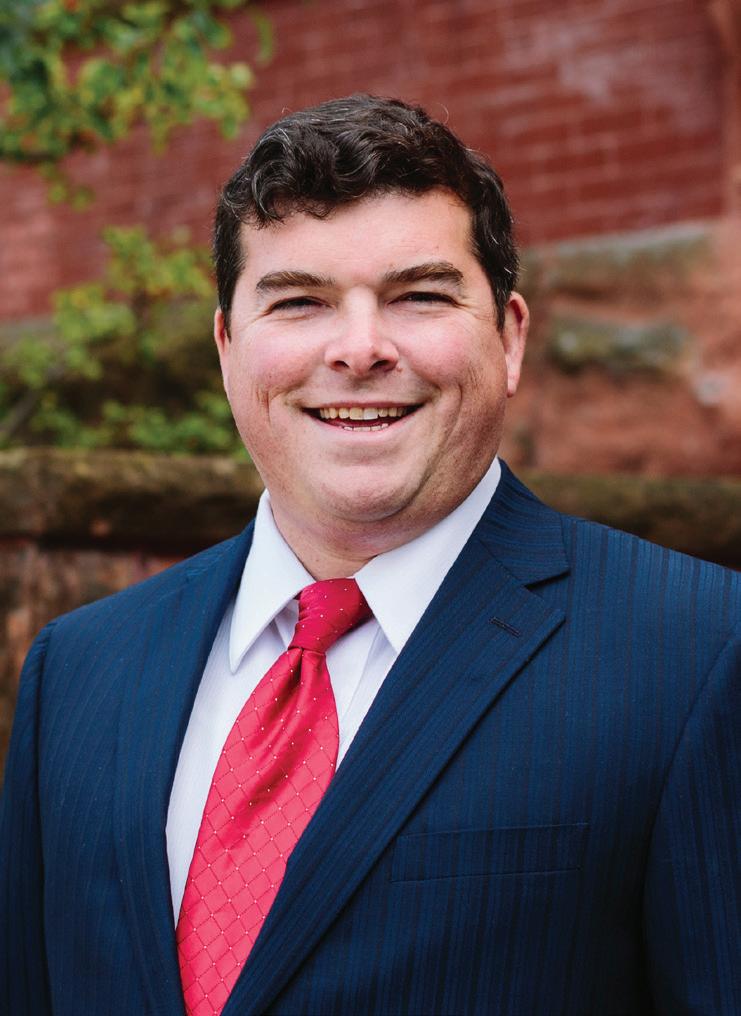
man Plumstead says he thinks the Loper Bright decision could cause more regulatory uncertainty for financial institutions.
“My perspective is that the decision will change how banking regulators write their rules because of the increased legal challenges they may face,” he said. “While it’ll take time to see the full effects, we’ll likely see more lawsuits about banking regulations in the short term. Down the road, this could make the regulatory environment more complicated.”
Andrew Kempf, president and CEO of 4Front Credit Union, says the end of

Chevron deference could slow the deluge of rule-making that often occurs near the end of a presidential administration.
“Every four years things change, which confuses consumers and business,” he said. “It’s untenable.”
For example, Kempf says he’s seeing a “rush” of agency rules coming forward that could get overturned if Republican Donald Trump wins the November presidential election.
But a potential flood of lawsuits challenging agency rules citing the Loper Bright decision could take years to resolve,





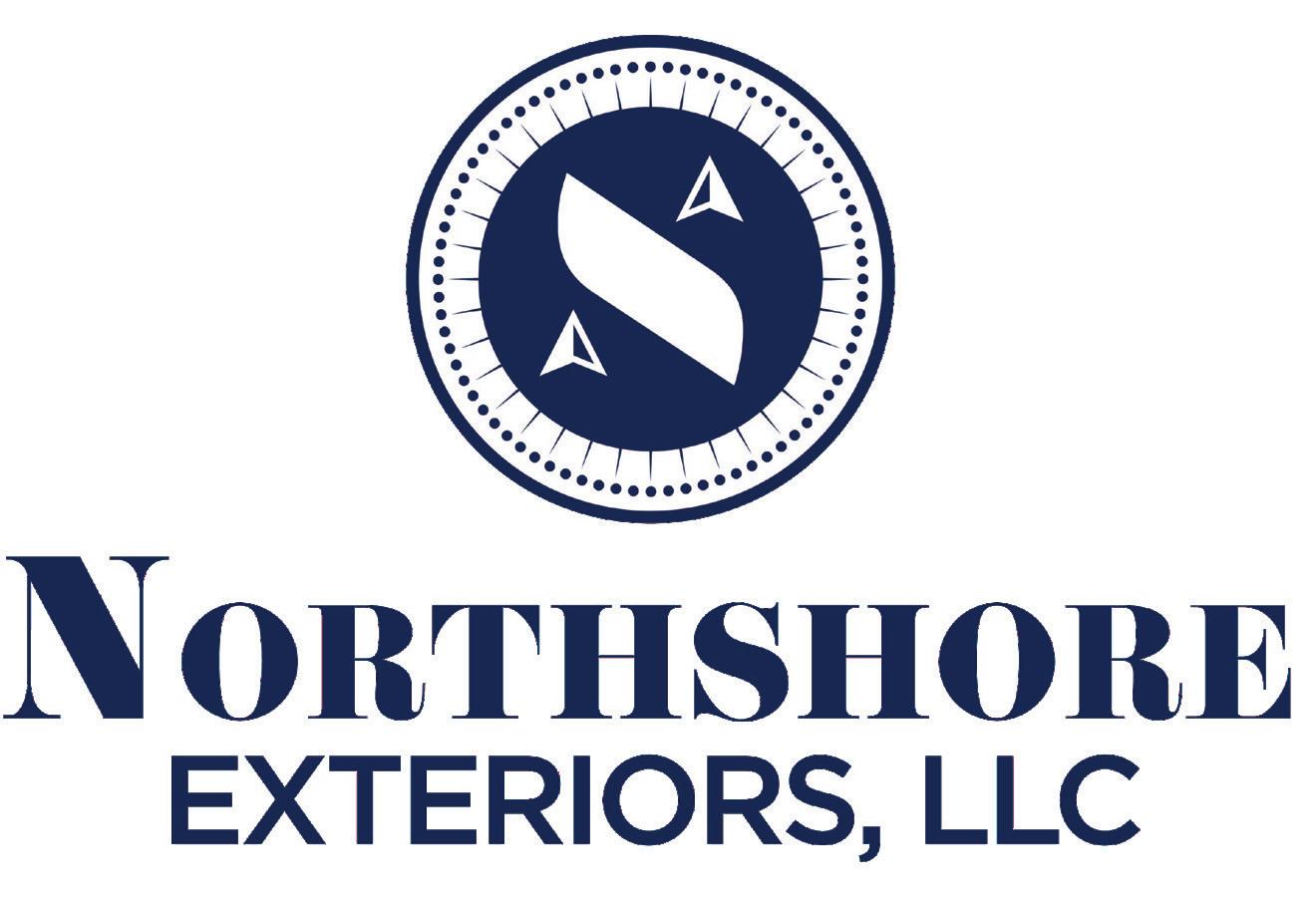
“My perspective is that the decision will change how banking regulators write their rules because of the increased legal challenges they may face. While it’ll take time to see the full effects, we’ll likely see more lawsuits about banking regulations in the short term. Down the road, this could make the regulatory environment more complicated.”
– Norman Plumstead, President and CEO, Honor Bank
creating “a very confusing environment for all of us in the financial institution space, as well as our members as we navigate our new reality,” he said.
Advocates for people with disabilities fear the end of Chevron deference will lead to rulings by conservative judges that could gut the Americans with Disabilities Act. The landmark 1990 law prevents discrimination against those with disabilities in a wide range of areas, including employment, health care, transportation and government services.
But Brandon Dornbusch, a Traverse City attorney whose practice encompasses elder law and representing families with special needs, said the Loper Bright decision might also result in the removal of overly restrictive rules that prevent
certainty in the regulatory landscape in general,” Dornbusch said, “it opens up a lot of opportunities for disability advocates to push back (against rules) that unduly restrict the ability of individuals and families to plan for their future and qualify for benefits.”
For example, the state’s interpretation of asset limitations to qualify for some Medicaid-paid care under federal law is often so strict “that it’s impossible for an applicant to qualify,” said Dornbusch, who’s on the board of directors of the Disability Network of Northern Michigan.
Legal experts say stiff new Environmental Protection Agency pollution rules for power plants are also likely to be chal-
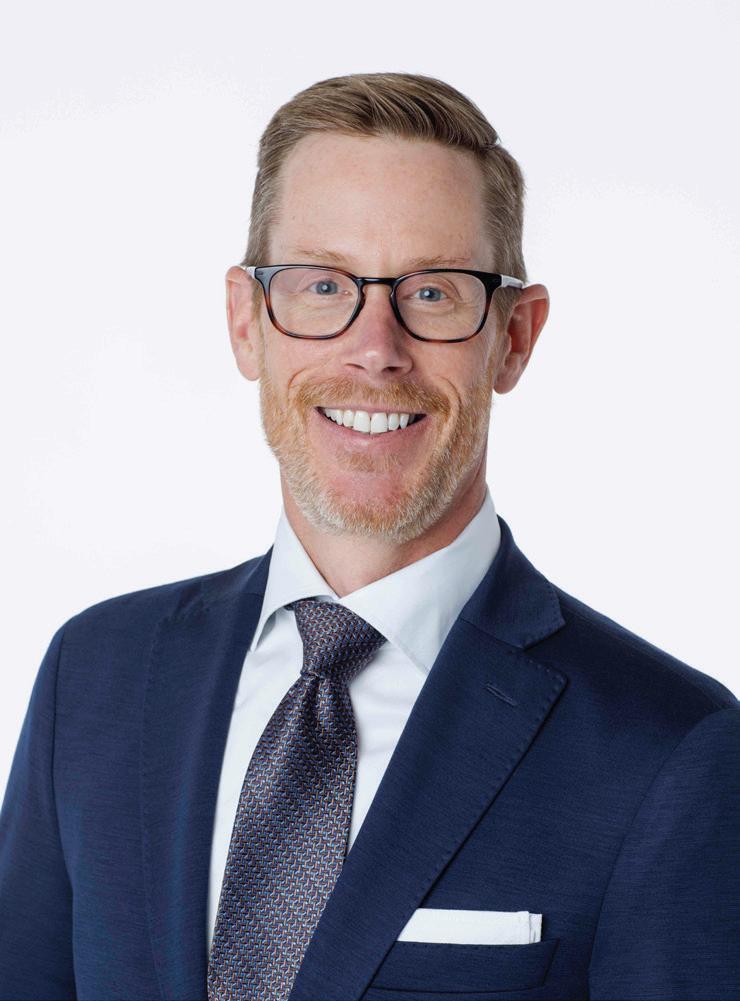
said the Loper Bright ruling “is certainly significant in terms of altering a 40-year precedent.”
But she also says the decision should have little short-term impact on the municipal utility, because it doesn’t generate its own power. Light & Power jointly owns a power plant and purchased power contracts with other utilities.
Lynch says the significance of the Loper Bright decision for businesses, and state and local governments could
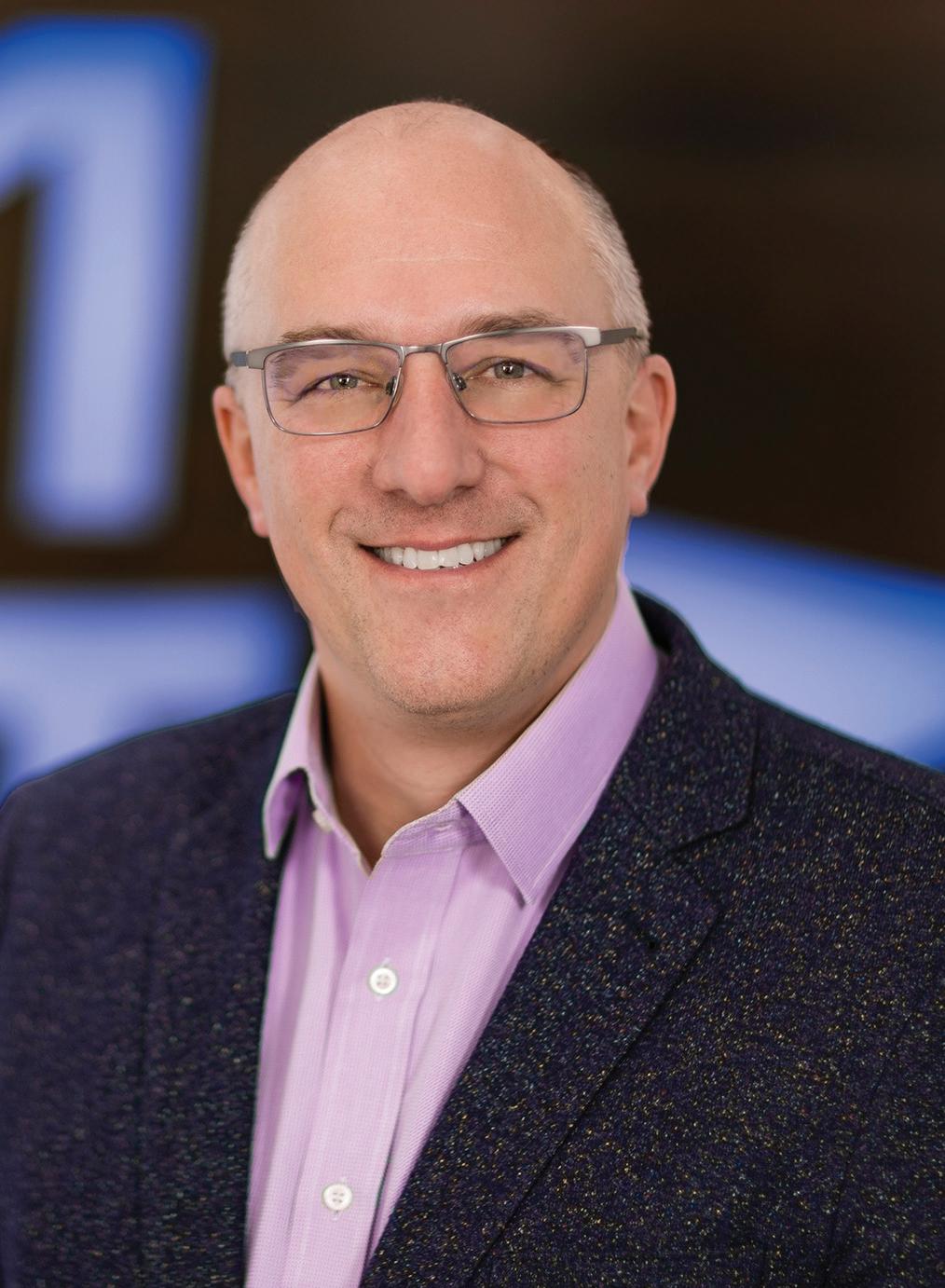
rule-making agencies, such as the Michigan Liquor Control Commission and the Michigan Department of Environment, Great Lakes and Energy.
A 2018 Michigan Supreme Court ruling ended Chevron-style deference for state agencies and said courts must decide the meanings of ambiguous state statutes. But the decision also allowed for the “respectful consideration” of agency rulings, which has muddied its enforcement.




By Art Bukowski
Health insurance is big. It’s rigid and established. There’s simply not a lot of room to reinvent things.
That’s not going to stop Rick Abbott from trying.
Abbott is the (relatively) new senior vice president of employer solutions at Priority Health, one of the biggest players on the Michigan health insurance scene. He’s spent about half of his career in health insurance and half in small startups, where rocking the boat is not only common, but necessary.
His goal at Priority is to show that the status quo isn’t sacred, even if change seems overwhelming or impossible in a relatively static industry. Throw a little of that startup mindset in there, he says, and watch the magic happen.
“What we’re trying to accomplish here at a high level is to make healthcare far more affordable and better from an experience perspective, but at a more specific level, I want to demonstrate that health plans that have been around for 30 years can actually disrupt the healthcare ecosystem from the inside,” he said. “We can make a difference.”
In his role, Abbott leads Priority’s commercial business, serving companies large and small across Michigan. He oversees a market-focused team that includes product innovation, wellness, underwriting, sales and client services, sales operations and marketing.
“It’s a pretty broad role that gives our team the ability to really impact change, and do so in a way that is far more quick than others across the country,” he said.
He came to Priority in June 2023 after most recently serving as co-founder and CEO of Lyn Health, a startup that provided clinical, advocacy and care coordination services for people with multiple chronic conditions.
Prior to that, the Chicago-area native and father of five spent several years in various roles at Blue Cross Blue Shield and Aetna, along with several years playing key roles in healthcare startups. Time in “both worlds” provided various important lessons, but the hustle of startup culture is something that still gives him energy and guidance.
“The trait of scrappiness inherent in
“What we’re trying to accomplish here at a high level is to make healthcare far more affordable and better from an experience perspective, but at a more specific level, I want to demonstrate that health plans that have been around for 30 years can actually disrupt the healthcare ecosystem from the inside. We can make a difference.”
- Rick Abbott, Senior Vice President of Employer Solutions, Priority Health
startups is invaluable,” he said. “The ability to say, ‘I’m going to have resilience and I’m going to focus on the solution and work through every single barrier that I can to get to what I need.”
Abbott also has experience being uninsured (he was part-time at his first stint at Blue Cross Blue Shield), which motivates him to make such a vital benefit more accessible.

“So here I was working at Blue Cross and I was uninsured, which is kind of crazy to think about,” he said. “And I remember that time how scared I was to go to a doctor because I had to pay the whole bill. You kind of walk on eggshells because if you break an arm or something catastrophic happens, that’s your bill, and you’ll be scared about where you can go (for care).”
A company like Priority is in an ideal position to drive change, Abbott says, especially when you look at it from a purely resource standpoint.
“I think there are things we are able to do here that any startup or progressive company would love to be able to do but just can’t because they don’t have the financial or technological assets,” he said. “We have an abundance of resources here to tackle really big problems, so I’ve challenged our product team: How do we look at the resources we have and use them to be innovative and pioneering?”
Idealism is also not lost on Abbott, who pushes his team to remember that the mission of a health insurance company is first and foremost to help people get the care they need.
“We want to…lift up our communities,” he said. “We really want to impact the vulnerable population.”
Thus came several initiatives designed to boost accessibility to (and affordability of) services, a general theme of programs begun under Abbott’s watch.
“We’ve launched programs that give people access to physical therapy through artificial intelligence in the comfort of their own home so they can actually go through those treatments and do it when
it’s convenient for them. It’s highly accessible and it’s completely free to them,” he said. “We’ve also made fertility benefits and adoption and menopause benefits infinitely more affordable and accessible by how we contract with startups that actually do those services really, really well.”
A few months ago, Priority launched a program with virtual care provider Curai
are,” Abbott said. “Can we solve all of the health problems that everyone might have? No, but at least we can give them a starting point and point them in the right direction to resources that might be available to them.”
The startup junkie in Abbott wants to not only bring more services like these online, but to get them spreading throughout the healthcare industry.
“Most people who carry health insurance with any company view their health insurer as a financial company, and I think that’s what fundamentally has to change. I want people to view their health insurer as an advocate for them that helps them navigate the entire health care ecosystem… to know that your health insurer is constantly thinking about you and your needs and doing things proactively to make your life easier.”
- Rick Abbott, Senior Vice President
of Employer Solutions, Priority Health
Health that provides free virtual visits to Michigan residents 18 and older who don’t have health insurance. While virtual care has some drawbacks, it’s a huge jump in the right direction, Abbott says.
“You can live in a very rural community with no provider access at all or in downtown Detroit, and either way we’re going to be able to bring access to you right where you
“(The startup mentality is to) demonstrate that you can solve a very specific need and do it better than anybody else, and then take that core concept and expand it to more populations,” Abbott said. “Get something out that we know is high quality, has been tested and will impact the lives of the members we serve, and once we prove it does, then let’s scale and expand it.”
That requires cooperation between providers and insurance companies, something Abbott says is vital to future innovation in the industry.
“A health system has to make sure they’re being reasonably compensated for the services they provide and a health plan has to make sure that compensation isn’t higher than it needs to be to be able to keep health care affordable. That can create a lot of friction between the two most dominant players in the health care system,” he said. “The more we can find partnerships and collaborations between health systems and health plans, the better we can work together to make sure that people…have a great experience.”
Ultimately, Abbott’s goal is to change the way people think about health insurance. It’s not going to happen overnight, but it can happen one step at a time with programs like those described above, he believes.
“Most people who carry health insurance with any company view their health insurer as a financial company, and I think that’s what fundamentally has to change,” he said. “I want people to view their health insurer as an advocate for them that helps them navigate the entire health care ecosystem… to know that your health insurer is constantly thinking about you and your needs and doing things proactively to make your life easier.”







By Michael Corby, columnist
As we enter the holiday season and begin looking ahead to the New Year, it’s a time that is accompanied by a sense of new hope, which is something we are seeing tangibly take form at 410 Brook St. Thanks to significant investment over the last year by Grand Traverse County, state and federal government, Munson

By Terri Lacroix-Kelty, columnist
Healthcare (MHC) and Northern Lakes Community Mental Health Authority (NLCMHA), our community now has the resources to establish the Grand Traverse Mental Health Crisis and Access Center (GTMHCAC).
With The Center set to open Jan. 5, we are in the final stages of constructing,
staffing and operationalizing the project that when complete will provide care to patients at any age, regardless of their ability to pay.
Michigan is among the most under-served in the country when it comes to the accessibility of mental health resources, and this is especially true in rural areas of the state like northern Michigan. This will change for us in the coming year as The Center provides expanded access to this care and brings mental healthcare services under one roof in a physically, psychologically and emotionally safe environment that promotes healing and growth.
Led by a director and leadership team of community mental health partners, The Center will be subject to the same staffing and operational complexities as any other non-profit healthcare organization. However, a shared staffing model between NLMCHA and Munson is designed to gain efficiencies that will aid in providing timely access to care and help reduce strain on other community
resources such as emergency departments and jails.
To meet the needs of the community, we will incrementally add services and increase hours of operations as we ramp up staffing in four phases between January and fall 2025.
In Phase One, the center will open its doors on Jan. 5, 2025, initially operating Sunday through Thursday from 8am-8pm with NLCMHA providing:
• A Welcoming Center where patients can receive behavioral health assessments as well as information and referrals connecting them to resources in the community and to outpatient therapy
• Crisis phone screening
• Mobile crisis and peer support services
Phase Two is anticipated to begin July 1, 2025, at which time the facility will be open 24 hours a day, seven days a week. This phase will include the addition of psychiatric urgent care operated by Munson and a “Living Room” model of care
facilitated by Northern Lakes.
Psychiatric urgent care is an intermediate level of care between community-based services and acute care services, such as an emergency department or inpatient care. This level of care can often prevent urgent situations from escalating while also providing a broad range of mental health services that include:
• Medication management
• Crisis intervention
• Stabilization
• Counseling
• Social work and psychiatric assessment
• Illness education
• After-care plan
The Living Room model of mental health care is based on the idea that people experiencing a mental health crisis want a safe, home-like place to go that isn’t a hospital or emergency department. In this more comfortable, non-clinical setting, people will be able to receive crisis intervention, stabilization services and support from staff who have their own experience with mental illness or substance use disorder.
Phase Three will include nine NLCMHA adult residential beds slated for summer 2025, with Munson Healthcare’s six pediatric residential beds scheduled to come online during the final phase sometime in fall 2025. The timing of the
final two phases will be dependent on the licensing process.
Even more important than the brick and mortar of the center is the team we are building to provide support and care for our patients. Healthcare overall is experiencing nationwide staffing shortages which can be even more prevalent within mental health services. According to Mental Health America, only one mental
region will have a determining role in setting the dates to opening residential care units.
When we look back a year from now, we will see benefits from putting this crisis services continuum in place. Research tells us that:
• Eighty percent of those using hotline services will resolve their crisis over
The model is designed to provide multiple options for those in mental health crisis with the ultimate goal to provide care upstream, before someone reaches a point of crisis.
health care provider is available for every 350 people in the U.S.
We are well into the process of recruiting and hiring more than a dozen master’s degree, bachelor’s degree, and registered nurse positions to staff the center. While the quality of life in northern Michigan coupled with the opportunity presented by this new program makes it an attractive prospect for job candidates, their availability to relocate to the Grand Traverse
the phone.
• More than 70% receiving care from mobile teams will resolve their crisis in the field.
• Nearly 70% of those who come to the GTMHCAC will be discharged to the community.
• Eighty-five percent of those receiving care in any of these three venues will remain stable through community-based care.
The model is designed to provide mul-
tiple options for those in mental health crisis with the ultimate goal to provide care upstream, before someone reaches a point of crisis. Doing so will help prevent overburdening law enforcement and emergency medical staff, reduce demand for inpatient behavioral health beds and most importantly, ensure people are receiving care in a setting that is most conducive to helping them heal.
An open house is being scheduled for December to introduce the center to the public and celebrate this far-reaching collaboration between community mental health partners and non-profits; Grand Traverse County; local, state and federal elected officials; the Community Advisory Group; CHIR Behavioral Health Initiative and the United Way.
This project truly reflects the strength and compassion of our community. We should not only be proud of the new path we are helping to forge for other rural areas like our own but optimistic about taking this step toward greater mental health and well-being for our friends, neighbors and loved ones.
Michael Corby is the behavioral health director for Grand Traverse Mental Health Crisis and Access Center. Terri Lacroix-Kelty is executive director of behavioral health at Munson Healthcare.

Health care careers start at NMC
Nursing: Practical nurses (PNs) Licensed practical nurses (LPNs) Associate degree (ADNs) Bachelor of science (BSNs) (through Davenport University)
Medical billers and coders Physician Assistants (through GVSU at the University Center) Surgical Technologists








By Andi Dolan, columnist
Operating a business in northern Michigan requires the delicate balance of both grit and grace.
Our beyond-stunning, four-season landscapes and vibrant festival-filled shorelines present unique challenges for business owners, especially when it comes to recruiting and retaining skilled employees.
Attracting seasonal workers while also engaging and keeping current hires happy is vital for developing a successful and sustainable workforce. Identifying the right talent is just one aspect…determining which benefits to offer and managing them within a budget demands a thoughtful and ongoing strategy.
Implementing impactful programs that are both cost-effective and enhance employee satisfaction doesn’t have to break the bank. Here are a few budget-friendly items to add to your annual open enrollment offerings.
One of the least expensive, yet highly valued benefits, is group life insurance. Typically, these employer-paid policies are guaranteed issue, meaning employees receive coverage regardless of any pre-existing conditions – no awkward medical questions are asked. Offering a group life plan not only shows that you care about your employees, but it can also positively influence your recruitment efforts.
For approximately $10 per employee per month (PEPM), employers can provide a solid, basic life insurance plan that offers priceless peace of mind for employees and their families. Knowing their loved ones are financially protected in the event of an unexpected loss creates a supportive workplace atmosphere. This is one mighty way to invest in your employees and strengthen their loyalty to your organization.
Another wise and very timely enhancement for your menu: offering an Employ -

ee Assistance Program (EAP). EAPs deliver confidential counseling and support services to help employees tackle personal and professional challenges. This low-expense and highly valued resource averages $25 to $30 per employee, per year (PEPY). Providing employees and their families access to mental health support, financial counseling and legal advice fosters an environment that prioritizes their overall wellness. EAPs can significantly improve productivity, reduce absenteeism and contribute to a more positive work culture and climate.
Employer-paid group accident plans are an inexpensive and valuable investment that offers financial safeguards for employees facing accidental injuries, on and off the job. By providing assistance for unexpected medical expenses, hospital stays and emergency room visits, these plans help alleviate financial stress for your hard-working crew. Ranging from $8-$25 PEPM, employers can show a strong commitment to their team’s financial fitness when unforeseen mishaps occur.
Flexible Spending Accounts (FSAs)
Flexible Spending Accounts (FSAs)
are another cost-effective benefit to add to your menu. With a low start-up price tag and small admin fees, $60 PEPY is a bargain considering the significant tax savings this vehicle provides.
Employees may allocate more than $3,000 pre-tax dollars from their paychecks to an FSA to offset their ongoing annual medical, dental, vision expenses. This benefit may also allow for $5,000 of pre-tax dollars to be used for dependent daycare expenses. Bonus feature: employers may make tax-free contributions of up to $500 to eligible employees’ accounts, offering extra financial support (and further tax savings).
FSAs encourage employees to plan for their annual expenses, in turn easing financial burdens and promoting better financial management. A key advantage: employees may access their full contribution at the beginning of the year, allowing for immediate use for eligible expenses.
A frequently overlooked feature of employee benefits is the importance of clear and comprehensive compensation statements. These annual summaries outline total rewards, not just including salary, but also Medicare, Social Security payments, employer contributions for
health premiums, 401K, paid time off and all other perks in-between. By providing this transparency, employees can better understand the full value of their compensation package. This clarity not only enhances their appreciation but also strengthens their connection to their employer’s commitment to their financial and personal health.
Enhancing your benefits menu doesn’t have to be costly. Affordable options are not only achievable but essential. With group programs such as life insurance, EAPs, accident plans and flexible spending accounts, employers can provide valuable support to their workforce without straining their budgets.
Regularly reviewing and communicating this information not only helps employees feel valued but also plays a crucial role in building a motivated and satisfied team, ultimately contributing to longterm success for both the employees and the organization. In northern Michigan we work hard and play hard! Protecting your team’s well-being today will yield lasting results.
Andi Dolan is the owner of Traverse Benefits, a local independent insurance agency advocating and providing health, life and disability solutions for employers, individuals and Medicare beneficiaries across northern Michigan.

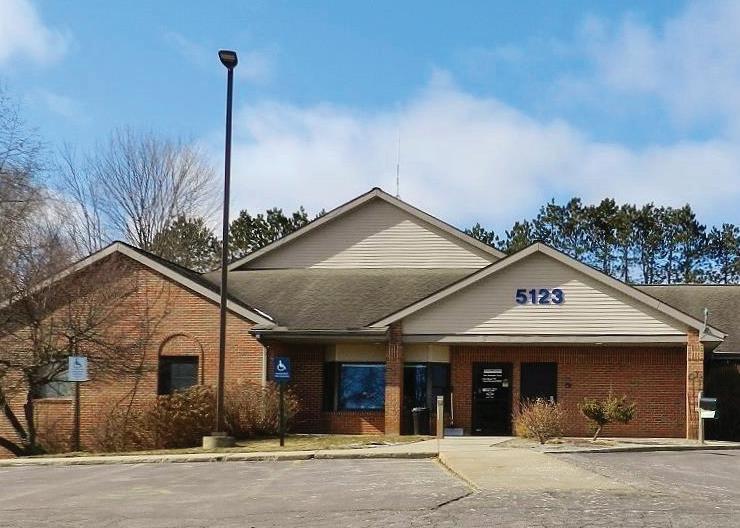
Medical Office Building For Sale! - 11,486
Sq/Ft. Main Level is 6,187 Sq/Ft. Walkout Lower Level is 5,299 Sq/Ft and Features a Large Open Area w/Picture Windows providing lots of natural light. Excellent for Physical Therapy, Patient Assessments, Gym Related Activities! Current tenant (month to month) is utilizing the lower level (some lab space), and approx. 2/3's of the main floor. The owner is using approx. 1/3 of the main floor & shared common areas. Owner leaseback is negotiable or buyer could use the entire building if needed. Many individual offices of various sizes. Close to Munson Hospital surrounded by a variety of Medical Practices. Virtual tour Online –MLS# 1919691 - $1,499,000.

MIXED USE COMMERCIAL - Great Opportunity - One Building a Large (40x44) Insulated Warehouse -15 ft Sidewalls -14x20 Sliding Doors for Large StorageSecond Building has a Reception - Office - Restroom Area and a Unique Building Attached with 11 ft Sidewalls - Epoxy Floors - Steel Ceilings - 3 Sink Stainless - Double Doors for Deliveries in Main Workspace w/4 Individual Work Rooms. Could be Opened up for One Large Space. Light Manufacturing could be a great Contractor or Woodworking Workshop! Rental or Cleaning Business, etc. etc. US-31 Highway Frontage & Exposure for Signage on Building. Improvements include 3 phase electric in both buildings - Paved & Plumbed w/ New Drainfield, & Security System. MLS# 1922900 $459,900.


By Kierstin Gunsberg
Northern Michigan dentists are dropping dental insurance carriers because of stagnant reimbursement rates and increasing operational costs.
Consequently, patients paying premiums for their employer-provided dental coverage are finding that their dentist no longer accepts their insurance, most notably Delta Dental, which is offered by some of northern Michigan’s largest employers such as Munson Medical Center.
Delta – which currently participates with thousands of dental offices across Michigan – appears to be the most commonly dropped carrier, purely based on numbers. But many dentists that are dropping Delta say they are simultaneously dropping other insurers too, or will soon.
That’s because “the reimbursement rates are not increasing with the cost of doing business,” said Dr. Hayley Popp of Associates in Family Dentistry.
“Dentistry
is an investment, not an expense. It’s still healthcare that everyone needs to live a healthy life.”
– Dr. Hayley Popp, Associates in Family Dentistry
Some insurance companies haven’t raised their reimbursement rates in a decade, says Dr. Ryan Paulson of Grand Traverse Smile Center, who adds his practice continues to accept dental insurance but understands why it’s becoming unsustainable for others.
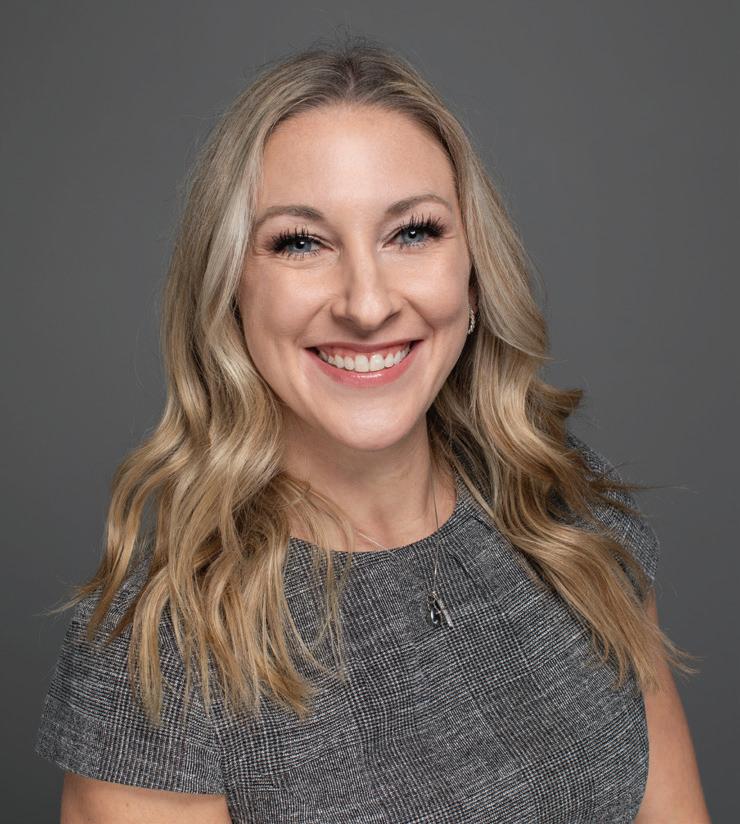
Some insurers like Delta Dental of Michigan claim to have paid an additional $184 million to providers over the last three years by raising reimbursement rates. Dentists argue that these rates remain outdated and say that the
compensation fails to cover the rising costs of running a practice and keep pace with inflation.
According to a 2024 American Dental Association report, earnings for general practice dentists have declined slightly over the past decade, with the average general practice dentist netting just over $218,000 annually. In Michigan, that figure is even lower – around $166,000, according to ZipRecruiter.
“We all know everything costs more. That isn’t any different for dentists,” added Paulson, noting that labor shortages in the hygienist and assistant pool and the need for competitive wages further drive up expenses.
In addition to rising labor costs, dental practices – most of which are run by sole proprietors or small partnerships – have to account for growing behind-thescenes expenses like equipment depreciation and office management software fees.
“Inflation has affected everything,” said Paulson.
Both Popp and Paulson note that the function of dental insurance has historically confused patients, who often assume it works the same way as health insurance. It turns out that’s not the case.
While dental insurance typically has lower premiums than health insurance, it also comes with annual coverage caps and only covers a percentage of most procedures. In contrast, health insurance has higher premiums and outof-pocket costs but no annual cap on coverage. Navigating this confusion has long been part of handling the billing side of the business, but it’s the increasing difficulty of getting paid by insurance companies that’s becoming the real deal-breaker for dentists.
The real hidden cost of running a dental practice isn’t just overhead—it’s the revenue lost from insurance companies capping reimbursements. To minimize their own expenses, insurers often limit reimbursement rates or require dentists

to write off portions of their services.
For example, if a patient with a $0 copay comes in for a basic dental cleaning and the office charges $112 for the service, the dentist would expect the insurance company to reimburse the full amount. However, if the insurance company only reimburses $78, the $34 difference falls on the dentist. That $78 might have covered all the supplies and labor for a basic cleaning a couple of decades ago, but not these days, say dentists.
In most businesses, price points would just increase to keep up, but dentistry is different, since most dentists base their pricing on guidelines set by their regional American Dental Association chapters. In northern Michigan, that’s the Resort District Dental Society.
Another challenge is the treatment guidelines imposed by insurance companies, says Popp.
She thinks that insurers are too quick to deem treatments unnecessary, basing their decisions solely on paperwork and predetermined policies instead of considering the patient’s long-term needs.
If an insurer doesn’t see a treatment or part of a treatment (say, nitrous oxide for a pediatric extraction) necessary, they won’t cover it. In turn, patients are hesitant to follow through on treatment plans.
“If the insurance believes a tooth doesn’t need a specific treatment based on the X-ray, it creates tension with the patient, who might ask, ‘Why does my insurance say I don’t need it, but you do?’” Popp said. “They’ve never met the patient or seen their entire mouth, nor do they understand the individual characteristics we consider when making treatment decisions. When they refuse reimbursement, they essentially tell us that because we’re in-network, we can’t bill the patient and must write off the costs.”
Shifting models and the perks of going out-of-network
That red tape, combined with the financial impact, is why some practices are choosing to go out-of-network or be-
“Dentists leaving insurance networks have determined that reimbursement rates don’t work for their practice for various reasons.”
– Dr. Ryan Paulson, Grand Traverse Smile Center
come “non-participating.” Popp’s group, Associates in Family Dentistry, is one of them. After the New Year, they’ll transition to non-participating status with all dental insurance.
For insured patients whose dentists go out-of-network, Popp explained that they’ll still have coverage, because dental insurance continues to cover portions of treatments and procedures regardless of a dentist’s participation status. But things will look different at the check-out counter. Instead of patients handing over their usual copay, they’ll now need to pay the full cost of treatment upfront, then wait on their insurance to reimburse them for the covered portion.
And that covered portion may be less than they’re expecting, since out-of-network dentists will be passing the cost that they used to write-off directly to the patient in addition to their copay. As for what the extra cost will look like, there’s no solid answer since treatment costs vary, but patients can expect to pay anywhere from an extra $30 to $300 or more per visit.
Stagnating reimbursement rates aren’t unique to Michigan. A 2023 American Dental Association report revealed that while private practice revenues rose by 2.2% nationally, expenses increased by

7.7%, resulting in lower profits across the country. In response, some urban dentists are turning to membership models similar to direct primary care (DPC), but Popp thinks it will take time for that trend to reach northern Michigan.
For now, she hopes her patients will recognize the value of maintaining oral health through preventive care, even if it costs more out-of-pocket.
“Dentistry is an investment, not an expense,” she said. “It’s still healthcare that everyone needs to live a healthy life.”
Meanwhile, some patients wonder if dentists are being greedy by going out-ofnetwork, but Paulson says that it’s not a decision made out of greed.
“Dentists leaving insurance networks have determined that reimbursement rates don’t work for their practice for various reasons,” he said. “It isn’t anyone being greedy or uncaring about patients. It’s just a personal and business decision that each individual dentist or group practice has to make.”
As for why so many dentists are making that decision now, Paulson says the challenges of working with dental insurance have been building over the last several years and have finally hit a tipping point.
“Some have just finally had it,” he said.


Open enrollment a busy time for HR professionals, insurance brokers
By Art Bukowski
It’s that time of the year again. Human resources professionals and benefits providers are in the thick of open enrollment. This is the designated (and often only) time employees can make important, sometimes life-altering changes to their health, vision and dental insurance or other benefits. Miss out now, and with the exception of a qualifying event (divorce, birth of a child, etc.), they’ll have to wait another year to make changes.
While some businesses that operate on a fiscal year go through this process in spring or summer, most businesses operate on a calendar year and are in the open enrollment window from October into early December to get the following year’s benefits in place.
The TCBN connected with HR folks and benefits professionals to talk about the importance, evolution and current state of this critically important practice.
The basics
Employees at most businesses and organizations now complete open enrollment online via various software programs, replacing the stacks of paperwork that were until a decade or so ago inseparable from this process. This makes the situation for both employees and employers faster, easier and less prone to error.
“If the enrollment process is…complicated or confusing, that definitely adds to difficulties,” said Hollie DeWalt, asso-
ciate vice president of human resources at Northwestern Michigan College.
“When you have software that works well, and we’ve used it consistently year over year, it becomes a much smoother process.”
There are other benefits inherent in such programs. Jennifer Ewing provides part-time HR services to several local organizations via Traverse City-based Human Resource Partners. She said the use of artificial intelligence in these (and many other) software programs leads to a very intuitive experience for employees.
“A lot of these platforms now have AI that will help, using things like chat boxes that will prompt questions and help them walk through the decision-making process,” she said. “That’s kind of a cool new use of AI.”
Before employees settle into the process, however, they need to know it’s coming, so HR folks like to hammer them pretty hard ahead of time to make sure this open enrollment window is on their radar. Although it’s different with every employer, most will set a limited window (usually no shorter than 10 days, often in November) in which employees can make changes to all available benefits.
“We do lots of communication in many different formats. Email, internal newsletters, things like that, and we have benefit guides that we send out,” DeWalt said. “We schedule Zoom meetings to go over all of the benefit information for the new year...I send calendar invitations to every person.”

Those helpful online systems also add an extra boost in this regard, DeWalt said, by making it harder for open enrollment to slip through the cracks.
“In our software system, if you haven’t gone in and made your elections, the system will send you a reminder,” she said. “So that helps to keep track of all of that.”
All things combined create a relatively “well-oiled machine” in which few people miss the open enrollment window at NMC, DeWalt said. But it happens.
“If someone comes after the window’s closed, then we’re going to look at that on a case-by-case basis,” she said. “If someone doesn’t get enrolled in a benefit before the new benefit year begins in January, however, then there does have to be a qualifying event in order to make a change.”

While representatives from the insurance companies or other benefits providers are sometimes involved, it’s far more often that employers bring in folks from their insurance brokers to educate employees and answer questions before and during the open enrollment period.
“A strong, well-rounded agent broker will be fully participating in that open enrollment process. They may be on site doing large group meetings or one-on-one meetings to explain the new benefits package. They’re creating handout materials that you can share with employees,” Ewing said. “A good agent broker can really make or break the enrollment process.”
That’s in part because what seems like a straightforward process can often be a true struggle for many employees trying

“We focus a lot of attention on building that understanding of what generates rate increases and ways they as a consumer can help mitigate that. So not to take anything away from our local hospitals, but if we’re trying to contain and flatten our renewal rates year over year and save the individual some out of pocket money, we are going to educate and make sure that they’re aware of these other outlets.”
- Kurt Swartz, managing partner, Michigan Planners
to make the best and most cost-effective decisions about coverage, and the brokers are intimately familiar with the plans they lined up for their clients.
“If my spouse works in company A and I work in company B, how much would my spouse pay for an individual plan? Is it cheaper for them to be on my plan? Should my children be on one plan or the other?” Ewing said. “People can really struggle with decision-making and what’s best for the family for that year.”
Kurt Swartz is managing partner at Michigan Planners, a broker that through its Traverse City office coordinates the benefits for the City of Traverse City, Goodwill Industries, Shoreline Fruit and many other private and public organizations in northern Michigan.
“We focus a lot of attention on not only servicing the C-suite decision makers at the employer, but also on the employees and being there as a resource for them and their insured dependents as they navigate insurance,” he said. “So that really alleviates a lot of the revolving door noise that comes to the HR professionals.”
During open enrollment (and indeed throughout the year), Swartz’s goal is to keep as much work as possible off the HR department’s plate.
“We funnel all of that through our agency so that it frees up the HR folks to do what they do best, which isn’t administering the benefits, but focusing on their employees, recruiting, retention
and overall culture at their company,” he said.
Aside from getting people into the right plans and benefits by asking good questions, Swartz said his firm works hard to keep costs down for employees during the upcoming year and over time, and a lot of that is done through education. An MRI at an independent imaging center might cost a fraction of what it does at the hospital, for example, but people can’t take advantage of that if they don’t know about it.
“We focus a lot of attention on building that understanding of what generates rate increases and ways they as a consumer can help mitigate that,” he said. “So not to take anything away from our local hospitals, but if we’re trying to contain and flatten our renewal rates year over year and save the individual some out-ofpocket money, we are going to educate and make sure that they’re aware of these other outlets.”
Finally, a good agent can help you avoid overpaying for the plan itself, Swartz said.
“The struggle that we have that’s happening more often is individuals who are relatively healthy will allow themselves to be talked into a more expensive insurance plan by their co-workers and peers versus listening to an insurance professional,” he said. “And they’ll spend years in these plans overpaying for insurance that they may only use for preventive care or maybe not even use at all.”
Certified WOC nurse, specially trained at the prestigious Cleveland Clinic. Holistic,


Wound Care Expertise
Ostomy Support Continence Care/Resolution
For compassionate in-home care for your loved one, lean on us.

By Craig Manning
More than $1 million of donated dental health services, impacting 1,700 patients across 2,400 patient visits.
That’s a quick rundown of the first 365 days at United We Smile, the first-ofits-kind charity dental clinic United Way of Northwest Michigan (UWNWMI) launched one year ago.
Speaking to TCBN sister publication
The Ticker last spring, UWNWMI Executive Director Seth Johnson said his team had spent much of the pandemic looking “at how we can better serve the community.” As he explained it, the community impacts of UWNWMI – and other United Way branches across the country – have historically “been a lot around fundraising and grant-making.”
COVID-19 got the organization thinking about how it might be more hands-on in meeting local needs, with UWNWMI ultimately landing on dental care as an
area where it could orchestrate some much-needed change.
“We realized that there’s just a massive lack of dental care for children in our region, as well as for pregnant women, for
“I’ve
School of Dentistry and Traverse City’s Resort District Dental Society (RDDS) to treat patients who might not otherwise be able to afford dental care. The clinic opened its doors at Copper Ridge in
definitely had a lot of calls from other United Ways. They’re saying, ‘How did you do this? Dental care is an issue in my community, too. How could we structure something like this?’ No one’s done it yet, but we’re happy to help if they do.”
–
Seth Johnson, Executive Director, United Way of Northwest Michigan
veterans, and for those with developmental and cognitive disabilities,” Johnson said. “It got us thinking about what we could do to address those problems.”
That thought process led to United We Smile, which harnesses donated services from the University of Michigan
September 2023, making UWNWMI the first of the more than 1,100 United Ways around the world to operate its own dental clinic.
A year later, Johnson says UWNWMI might have actually underestimated how much northern Michigan needed a free-
of-charge dental clinic.
“We have a big waitlist of veterans who are interested in becoming patients,” Johnson said. “We have people who are traveling long, long distances to get here. We have families coming from far south of Cadillac, or from the U.P., just to receive care. I think that shows how wide of a need there is for dental care. It’s quite striking and stark – and daunting.”
“Daunting” might be an understatement given how demand at United We Smile still far outstrips the clinic’s capabilities. One of the big goals for year two, Johnson says, is to shorten that gap.
“We want to be able to serve more patients,” Johnson said. “We want to make sure we are continuing to offer a high level of care, but we’re absolutely looking at ways to increase accessibility of care as well. To do that, we need to become more solvent. The program really operates at a deficit at this point, because we’re seeing so many uninsured
individuals coming through; we were not anticipating the sheer level of patients who don’t have any insurance but need care. Of the veterans that we’ve seen, for instance, none have had insurance. That means that we have been doing all our work for the veteran community at no cost to them, and purely on philanthropic support.”
That’s where UWNWMI’s history as a fundraising powerhouse will come in handy. With a year’s worth of cases under their belts, Johnson says the United We Smile team plans on getting more aggressive about telling the story of the clinic to “the giving community” locally and beyond.
Case studies shared with the TCBN include helping a three-year-old boy whose dental issues were so severe that he stopped eating, or treating a Purple Heart veteran who had teeth problems from when a mortar shell exploded near his face during the Vietnam War. Whether it’s private donations, nonprofit support, or government grants, Johnson feels confident United We Smile will be able to up its fundraising game significantly now that it has a track record.
One area where United We Smile won’t be expanding is in the demographics it serves. When the clinic opened, UWNWMI limited its services to the groups it believed were most underserved by northern Michigan’s existing dental
The clinic opened its doors at Copper Ridge in September 2023, making UWNWMI the first of the more than 1,100 United Ways around the world to operate its own dental clinic.

benefits other parts of the population.

infrastructure: veterans, pregnant and nursing women, young children, HIV and AIDS patients, and people with cognitive disabilities. With demand across those groups already so high, Johnson says it’s unlikely United We Smile would ever be able to serve a broader clientele. Still, he’s hopeful the work the clinic is doing will have a domino effect that
“We want to do the best job that we can serving the patients in those targeted demographics that we already serve,” Johnson said. “I think there will always be a need for more dental care in this region, but I hope that, by us doing this, our other partners can be able to do more dental work for other patients.”
And speaking of domino effects, John-
son shares that the successful first year at United We Smile hasn’t gone unnoticed by other United Ways around the world.
“I’ve definitely had a lot of calls from other United Ways,” Johnson said. “They’re saying, ‘How did you do this? Dental care is an issue in my community, too. How could we structure something like this?’ No one’s done it yet, but we’re happy to help if they do.”














From proposal to installation to servicing, KEEN surpasses expectations! Our K1 Speed project was managed and implemented with impressive technical knowledge, careful attention, and timeliness. The installation team even worked around and alongside several other building projects to get us up and running on time. Their highly skilled team is amiable and always available to answer any questions we may have about our new system. It may be the go -karts, but the guys from KEEN even stop by from time -to-time to make sure everything is running smoothly!

~ Traverse Racing






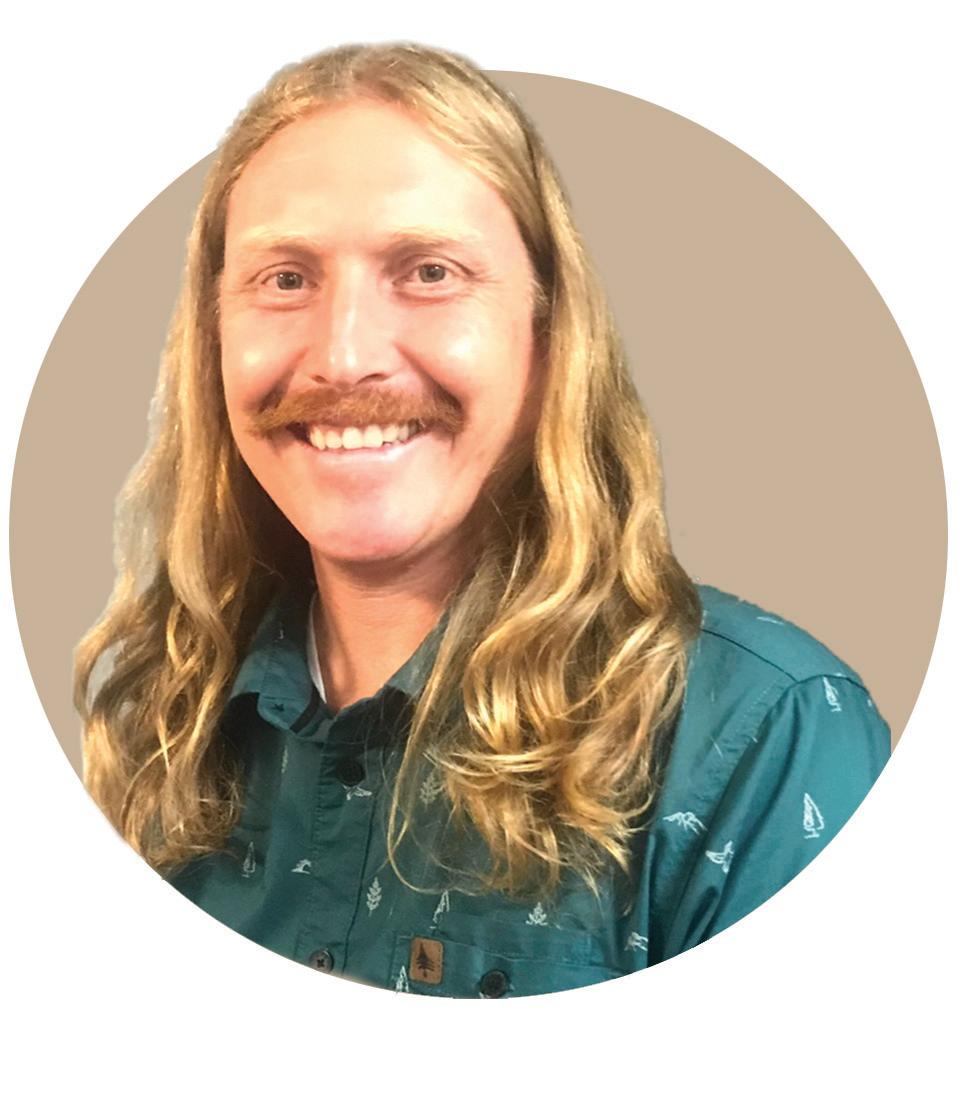
By Rob Hanel, columnist
As the holiday season unfolds, businesses face a unique set of challenges and opportunities.
While this time of year can be synonymous with festivities and joy, it also presents potential dips in employee engagement and overall mental health. High levels of engagement are essential for productivity in any organization, but the chaos of the holiday season can make it easy to forget that employees are at the center of any organization’s success. And what those employees feel about the companies they work for, their leaders, their teams, and themselves, ultimately provides the fuel for high performance. Bottom line, leveraging the holiday season to boost employee engagement can be critical for organizations aiming to finish the year strong.
It is unclear which term gets thrown around more these days, “culture” or “employee engagement,” but there is an undeniable correlation. Company culture is a shared set of workplace beliefs, values, attitudes, purposes and behaviors, and reflects both the written and unwritten standards that people in an organization follow. Employee engagement, on the other hand, is the alignment between the company culture and the employees’ individual cultural compass, which equates to the emotional commitment employees have to their organization.
During the holiday season, various factors, such as increased workloads, holiday stress, and personal matters, can impact engagement levels. Hence, it’s vital for organizations to remain proactive in fostering a supportive and engaging environment. The holiday season isn’t just a time for festivities, it’s also an opportunity to reflect on progress and build momentum for the upcoming year. So how do we as business leaders focus on engagement during the holiday season? News flash, it’s not buying your employees the latest trendy brandable item (I’m looking at you, Yeti and Stanley) or throwing swanky office Christmas parties. Rather, we should shift our focus to creating opportunities for personal connections amongst our teams.

Being inclusive, sharing traditions and staying flexible can deepen connections with your team
The holiday season is inherently personal. People tend to reflect on their lives, relationships, and achievements during this time. Employers can nurture this sense of personal connection by encouraging managers to engage with their team members on an individual basis. Simple gestures, like asking about their holiday plans or acknowledging their unique contributions from throughout the year OUTSIDE of their year-end review, can foster deeper connections. Don’t be afraid to ask about personal goals and objectives for the upcoming year, this allows you the future opportunity to check in with them on those goals, demonstrating care for both their professional and personal successes.
It’s important to recognize that the holiday rush can be hectic for everyone with dance and music recitals, school breaks, travel, visitors, last minute shopping etc. Offering flexible work schedules beyond existing flexibility can significantly enhance engagement. Allowing employees to manage their time allows them to balance work and personal commitments more effectively, and flexibility demonstrates a company’s commitment to employee well-being, boosting engagement.
Encourage employees to share recipes, family traditions, and/or photos from the
holidays. This can be as simple as a physical bulletin board or your company’s internal social media account. You could also sprinkle in a little competition in the form of a “Bake Off” or photo contest. Sharing holiday traditions is high on my list, it is a great way to get to know your co-workers in a fun and sometimes weird way. For example, I have an apron with the statue of David on
Go ahead, throw the swanky party or buy your employees a nice gift, but don’t forget to provide the gift of care and connectivity.
the front that I use exclusively for cooking during the holidays. Who wouldn’t want to hear the backstory to that? A good way to share traditions is to have employees submit them then share them at your company’s most popular recurring meetings or daily huddles. Not only does this provide cross
functional insight, you never know who may be inspired to start a new tradition within their own home/family!
It is also important to remember to practice inclusivity around the holidays. Diversity should be at the forefront of any holiday celebration; this can be incredibly personal. Hopefully you know enough about your employees and the varying traditions and beliefs amongst them, then organize inclusive events around that knowledge. This could mean hosting a holiday party that celebrates different cultures or encouraging employees to share their traditions.
Acknowledging and celebrating diversity develops a sense of belonging and, in turn, a higher level of engagement.
The holiday season offers a unique opportunity for organizations to enhance employee engagement. Go ahead, throw the swanky party or buy your employees a nice gift, but don’t forget to provide the gift of care and connectivity. By focusing on connection, inclusivity, flexibility, recognition, and well-being, employers can yield significant benefits in productivity, morale, and overall organizational health.
Rob = is the Director of People and Space at TentCraft and President of the Traverse Area Human Resources Association.

By Kierstin Gunsberg
As the holidays approach, northern Michigan retailers are kicking into high gear to pull off another successful gifting season. From meeting demand to managing both in-store traffic and online orders, here’s how four local retailers are handling the last shopping hurrah of the year.
At Benjamin Twiggs, owner Leisa Eckerle-Hankins starts preparing for the holiday rush as early as spring, stocking up on materials to package her signature cherry jams and syrups. By November, her small Traverse City shop is in full swing, assembling orders to meet the seasonal demand. Without careful planning, the space could quickly turn into Santa’s workshop.
“I’m small. I’m only one location compared to other businesses and retailers that
are, you know, much, much bigger,” said Eckerle-Hankins. “So, it’s a lot for us.”
With a team of 10 employees, Eckerle-Hankins doesn’t rely on seasonal hires to manage the spike in traffic and
Come November, shipments from Benjamin Twiggs become a daily event. Around 70 packages leave the storefront every day, headed to the company’s 100 wholesale clients nationwide, plus corpo-
“It’s a hustle and bustle, but we kind of thrive on it.”
– Leisa Eckerle-Hankins, Owner, Benjamin Twiggs
sales. Instead, her existing staff expands their hours, with part-time employees transitioning to full-time schedules through December.
“I have a very loyal and dedicated staff,” she said. “I’m very privileged to have them.”
rate gift buyers, who play a significant role in the store’s Q4 revenue.
Eckerle-Hankins estimates that corporate orders make up about 80% of her holiday sales across all channels, including online, in-store, and wholesale.
A main draw for corporate clients is
the time Eckerle-Hankins spends curating custom boxes for her Corporate Gift Program, which offers companies a 10% discount and personalization options. While many corporate gift buyers opt for boxes in the $250 range, her best sellers include the $25 Three Jar Gourmet Gift Box of jams and preserves and Ben’s Cherry Favorites, priced at $50 and featuring “a little bit of everything we do,” as Eckerle-Hankins describes it.
“So a little chocolate, salsa, jam, trail mix, and some sours,” she said.
And while last-minute shoppers straggle into the store in those final days leading up to Christmas and Hanukkah, Eckerle-Hankin’s last guarantee for holiday shipping is December 10. The crunch has her heading into the store as early as 7am and hustling it out until 10pm on most nights to put the finishing touches on orders.
“It’s a hustle and bustle,” she said. “But we kind of thrive on it.”

While Eckerle-Hankins and her team prepare for chilly shoppers both online and instore, Sue Burns, owner of Leelanau-based winter accessory brand BaaBaaZuZu, is taking a more direct approach by going straight to the shoppers – literally.
This year marks her second at the Christkindl Mrkt in Grand Rapids, a popular holiday market running from mid-November through December 23 that features more than 60 vendor booths and attracts thousands of shoppers seeking handmade gifts.
With many of the small boutiques that Burns previously sold to closing during the pandemic, BaaBaaZuZu’s wholesale accounts have dwindled. In response, Burns, who produces one-of-a-kind winter accessories from reclaimed felted wool, began exploring holiday craft shows and markets to sell her products directly to consumers.
Last year, she secured a spot at the
Christkindl Mrkt, which gives her the opportunity to return north for a breather since the market is closed on Mondays and Tuesdays.
“This came along and we were like, ‘That’s perfect,’” said Burns. “We set up our booth in a wooden hut that they provide. There it sits for six weeks, so we lock it up and come back to it after two days.”
Burns notes that this temporary setup is much easier than traveling to different craft shows and markets throughout the fall and winter months.
“It was very, very lucrative for us…so that’s really big on our roster this year,” she said.
BaaBaaZuZu’s top sellers at the market have been their sweater mittens and fingerless gloves, retailing between $58 and $98. This year, Burns plans to bring between 100 and 120 pairs of each of their three styles, which she has been designing and assembling throughout the year in preparation for her most profitable season.
“We call ourselves a fourth quarter

business. We liken ourselves to a Christmas tree farm (because) we start over January first,” said Burns. “It takes us the whole calendar year from the beginning to create enough inventory to shelf until we get into this fourth quarter when it’s time to start getting it out the door.”
As she prepares for another Christkindl Mrkt, Burns is strategically selecting her inventory, which she said shoppers snap up quicker when there’s a large selection of colors and designs to pick between for their gift-giving – maybe because that makes it harder to pick just one.
Corralling the crowds
Over on Traverse City’s Front Street, attracting holiday foot traffic is less of a concern and more of a balancing act for gourmet vinegar and oil shop Fustini’s.
General manager Liz Lancashire said annual downtown events, like the tree-lighting ceremony, Shop Your Community Day, and December’s ladies’ and
men’s shopping nights, always bolster instore traffic. And while summer shoppers often pop in to escape the heat, Q4 shoppers are more intent on making purchases.
Based on previous years, the store anticipates around 8,000 transactions between November and December, during which the store generates around 30% of its annual sales within just eight weeks.
To keep up, Fustini’s hires one or two extra employees shortly after school starts, coinciding with when they start requesting holiday orders from their corporate clients.
“Once we have those numbers crunched, we start producing and packing orders before Halloween,” said Lancashire.
During the holiday season, the store enlists even more help.
“We’re super lucky because we have college students and teachers that come in and help us every year,” she said, adding that it’s always a bit of a “scramble.”
“We probably almost double the staff for about six to eight weeks around Christ-















mas,” she said.
Lancashire points out one reason Fustini’s is holding steady year after year: an increasing number of gift-givers are choosing consumables over tchotchkes.
“The thing we hear all the time is that nobody wants to buy people more stuff they don’t need,” she said.
A little less hustle
It turns out that people do need to buy more stuff for their dogs though, and that’s something Stephanie Dehn, owner of Contigo Dogs, is counting on.
Dehn opened her retail shop in The Village at Grand Traverse Commons in 2023, following a successful launch as an online-only dog toy and accessory retailer.
As a newcomer to the seasonal retail landscape, she notes that so far, the holiday season hasn’t surpassed Contigo Dogs’ summer sales.
However, Dehn is targeting a 10% growth this December, as in-store shoppers – who account for 70% of Contigo Dogs’ revenue – head to the Mercato to





escape the cold.
While some business owners, like BaaBaaZuZu’s Burns, have struggled with the decline of in-person buyers, Dehn has been surprised by the opposite trend. Since opening her physical shop last year she said she’s actually seen a decrease in online sales, but seems to be making up for them in-store.
Originally from Brazil, Dehn’s perspective on the holiday hustle here in northern Michigan contrasts with her experiences back home where the season is less commercially driven. She doesn’t open during two of the year’s busiest shopping days – Black Friday and Christmas Eve –and said she doesn’t care if she loses out on sales because of it.
Last year, she and her staff of three even closed up shop shortly before Christmas until the second week of January.
“Not because of staffing shortages, but just purely based on the fact that I don’t want my employees to be working over the holidays when they could be with their families,” Dehn said. “And that’s much more important to me than anything else.”


By Craig Manning
Shopping malls; big box stores; online shopping.
Over the years, retailers in downtown Traverse City have faced more than a few existential threats. As holiday shopping kicks off for the 2024 season, though, long-time shop owners in the downtown core say they are still going strong – even as a few of those “existential threats” fade off into the rearview.
Thirty years ago, it wasn’t clear whether downtown Traverse City would make it this far – at least as a shopping epicenter. Speaking to the TCBN all the way back in 2007, Bill Golden – co-owner of downtown’s Golden Shoes – reflected on the biggest shifts to happen downtown since his family got into the shoe business in 1954. His answer? The rise of shopping malls, which led many one-time downtown staples to leave downtown behind.
“The biggest change we have seen in downtown are the stores that are no longer downtown,” Golden said at the time. “Hamilton’s, Kresge’s, Woolworth’s, Trude Hardware, Penney’s and Sears: These were all great downtown stores that have either moved to the malls or are just not in business anymore.”
There was certainly a “shopping mall era” in Traverse City. Cherryland Mall opened in 1976, and both the Grand Traverse Mall and the Horizon Outlet Mall (now known as Buffalo Ridge Shopping Center) followed in 1992. Then, in 1996, the Grand Traverse Crossings shopping center – home of big-box retailers like Walmart, Home Depot, and Staples –opened right across the street from the
Grand Traverse Mall. Collectively, these malls made Garfield Township the shopping epicenter in northern Michigan.
The mall boom, which crested in the late ‘90s or early 2000s, corresponded with a period of blight in downtown TC.
Amy Reynolds, long-time owner of Horizon Books in downtown Traverse City, remembers that period. At the time, Borders Books & Music – then a fixture at the Crossings mall – was the biggest bookstore in town, both in terms of square footage and the number of customers it had walking through the door. There was much talk at the time, Reynolds notes, of big-box bookstores like Borders and Barnes & Noble stamping out the indies. That idea is even at the center of a major motion picture: the 1998 Tom Hanks/Meg Ryan rom-com
“You’ve Got Mail.”
Borders folded in 2011, and Barnes & Noble has gone through a series of highly-publicized ups and downs over the past decade. Horizon Books, meanwhile, is still standing.
“I think the ‘90s was definitely the peak of the big bookstore payday,” Reynolds said. “A lot of books were being sold at a lot of big, big stores. It was really a glamor time in the industry, and there’s been a lot of pull-back from that. But I think, if you want to talk just the book industry, I think it’s still really strong. People shop all over, but book people are still book people. They might listen to an audiobook, and then decide, ‘Oh, I loved that book; I need to own it in print.’
There’s still a lot of love for physical books, and so a lot of people still recognize the value of bookstores.”

“Last year, I think Ladies’ Night might have been the biggest day of the year. And the crazy thing about that is it’s all compressed between the hours 5pm and 9pm. It all happens in those four hours.”
–
Liz Lancashire, general manager, Fustini’s/downtown TC
Malls and big-box stores haven’t been the only threats to downtown. According to Forbes, about one-fifth of all retail purchases now take place online, with that fraction expected to be closer to a quarter by the end of the decade. In fact, most experts point to the rise of Amazon. com and other online shopping platforms as the thing that caused shopping malls to stall out and decline.
Small, independent stores like the ones downtown haven’t been entirely spared from those impacts, either. According to Golden, though, a lot of customers are
starting to lose patience with online shopping – at least when it comes to footwear.
“There’s a lot of counterfeit out there,” Golden says of the shoe world. “It’s pretty frequent now for people to come into the store ‘I got these shoes online and they’re falling apart.’ And then I have to say, ‘Well, sure, this isn’t real?’ And then I learn that they paid $39 for a pair of shoes that costs $110 MSRP. Bottom line, if it seems like too good of a deal, it probably is.”
Counterfeit isn’t the only reason Golden thinks shoppers are getting fed
up with online shopping. Long delivery wait times, high shipping prices, the headache of the return or exchange process, and the inability to touch, feel, try on, or test out products before you buy. Especially around the holidays, he says, more and more local shoppers are choosing in-store, face-to-face shopping as the safer option, and it’s bringing more people downtown.
While Golden admits that Christmastime “used to be much busier” at Golden Shoes, he says the holiday season is still a robust time for the retailer. December is regularly the store’s third biggest month, after July and August, and Ladies’ Night is reliably one of the biggest days for business in the entire year. Particularly popular around the holidays? Socks – “the number one seller” for the season, according to Golden – given their universal appeal as stocking stuffers.
In fact, when comparing recent Christmases to the busier ones from past decades, Golden speculates that shopping malls and online retail might not even be the biggest factor slowing sales: warmer, milder winters.
“Last year, we didn’t have snow, so I didn’t sell as many snow boots – not only as Christmas gifts, but just in general,” Golden said. “The weather definitely hurt my December business.”
For downtown retailers that are less affected by climate change factors, holiday
shopping has been even more vibrant in recent years.
“It just keeps getting better and better,” said Liz Lancashire, general manager of the downtown Fustini’s store.
She’s talking about the store’s Christmastime peak, which has been growing and growing since the business opened in 2008.
“I remember our first Christmas, we just briefly talked about Christmas before it happened. Now, we start talking about Christmas preparation in May, in terms of ordering items and figuring out what our production plans and how we’ll do all the marketing. So, it’s terrific; it’s just a matter of being able to keep up at this point.”
Lancashire estimates that Fustini’s now does 30% of its annual in the six weeks between mid-November and the end of the year. The kickoff is Shop Your Community Day – scheduled this year for Saturday, November 9 – which Lancashire describes as “almost like a trial Black Friday.” From there, it’s a near-constant rush, from Black Friday to the one-two punch of Men’s Night and Ladies’ Night.
“Last year, I think Ladies’ Night might have been the biggest day of the year,” Lancashire said. “And the crazy thing about that is it’s all compressed between the hours 5pm and 9pm. It all happens in those four hours.”
Big, well-known shopping events might help drive business downtown during the holidays, but Lancashire also points

to another factor that might explain why downtown shopping trends have been soaring for the past few years: the pandemic. Struggles for local businesses in the early months of COVID-19, she says, created a groundswell of support for “shop local” campaigns. That drive to support small businesses even translated to a big uptick for online sales at Fustini’s during the 2020 holidays – something Lancashire says has held strong ever since.
“I would never want to repeat COVID, but was very good timing for us in that people were stuck home and wanting to cook with good products,” Lancashire says. “It was also kind of a good training ground for us to get better at selling online. We have a lot of snowbirds, and they
might not be in one of our store locations for the holidays, but they know us from their summer home, so they shop online and send out gifts.”
Reynolds reports a similar shift in customer attitudes during the pandemic. In addition to a business “bump” in 2020, she says amusement products like jigsaw puzzles shot up in popularity that year and have continued to be big sellers ever since. In fact, while Horizon Books has been around for 63 years and counting, Reynolds says it saw its biggest year ever for sales in 2021.
“That was a good holiday season and a good year in general,” she said. “There was just pent-up demand, and I think some pent-up dollars, too.”
















Peyton Clevenger, Reagan Clevenger, Raimi Webb and Jacob Swander were among approximately 150 attendees at Groundwork’s Fall Fling at Stormcloud Parkview Taproom in Frankfort Oct. 12. Half of all beverage sales at the taproom went to Groundwork.
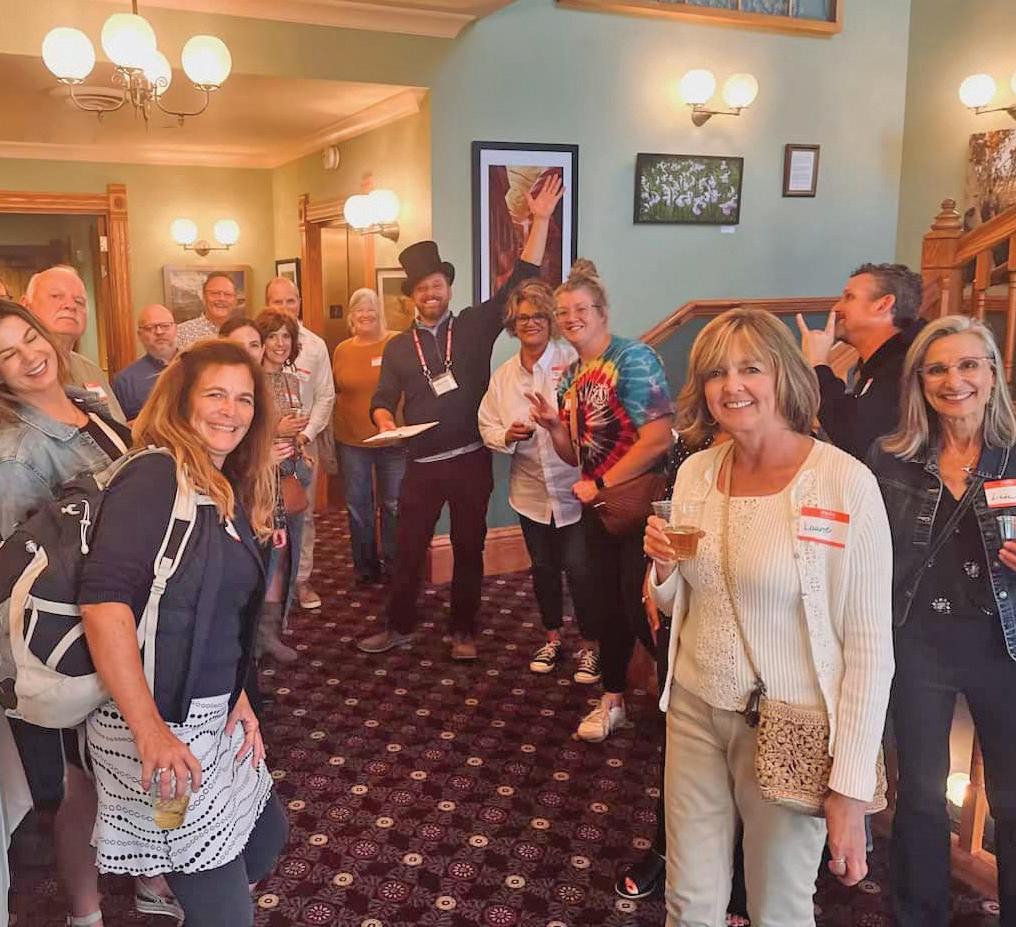
The City Opera House was the setting for The Ticker’s special fall Recess Oct. 2. Attendees enjoyed food and beverages from Identity Brewing Company, venue tours, and live music by Matt Hunter & AS Lutes.

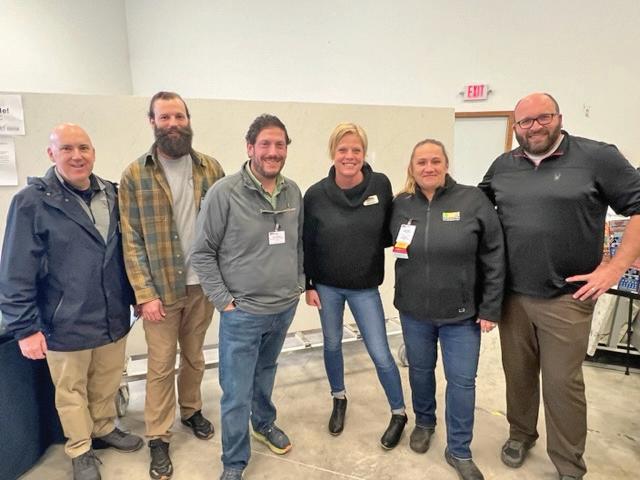
HBA held its monthly membership meeting at Nature’s Edge Fine Stone Products on U.S. 31 South. Pictured l-r: Terry Harper, Precision Plumbing and Heating; Blake Burns, Edgewater Residential Construction; Rick DeBlasio, Nature’s Edge; Lauren Tucker, HBA; Heidi Flake, CMB Construction; and Mike Tucker, Kingsley Lumber.
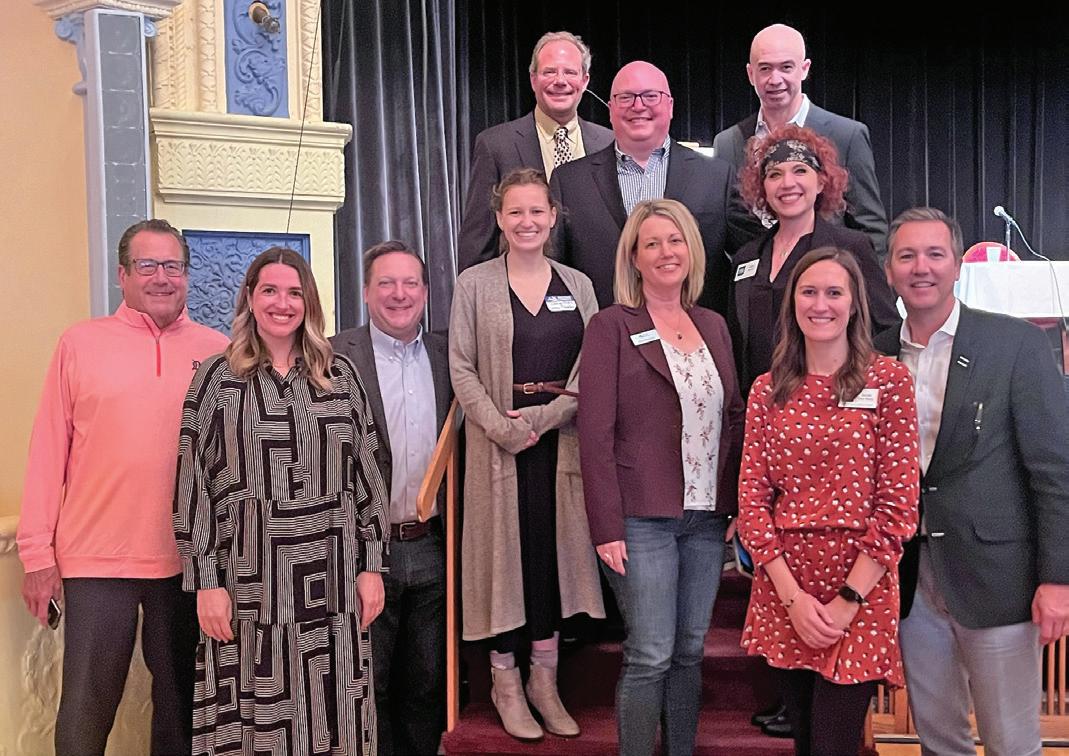
Northern Michigan Chamber Alliance Bully Pulpit and the Traverse Connect Candidate Forum took place at the City Opera House in September.
row: Russ Knopp, Comfort Keepers; Haley Bennett, Traverse Connect & Northern Michigan Chamber Alliance; Chris Hackbarth, DTE; Caitlyn Stark, Cadillac Area Chamber; Nora Balgoyen, ITC Holdings; Sarah Van Horn, CharlevoixArea Chamber; Warren Call, Traverse Connect. Second row: John Sellek, Harbor Strategic Public Affairs; Nikki Devitt, Petoskey Regional Chamber. Back row: Kyle
Northern Michigan icon, Terri Ray, has rocked the airwaves since 1984 on KLT The Rock Station As Program Director and creator of the ultra-popular Lunch at the Leetsville Cafe, Terri has built KLT into one of the market’s highest rated radio stations and has kept it there for decades. Her passion for radio and commitment to our community are big reasons why
You can see Terri in person this summer as she takes her show on the road with Lunch At The Leetsville LIVE - A look back at four decades of rock & roll in Northern Michigan
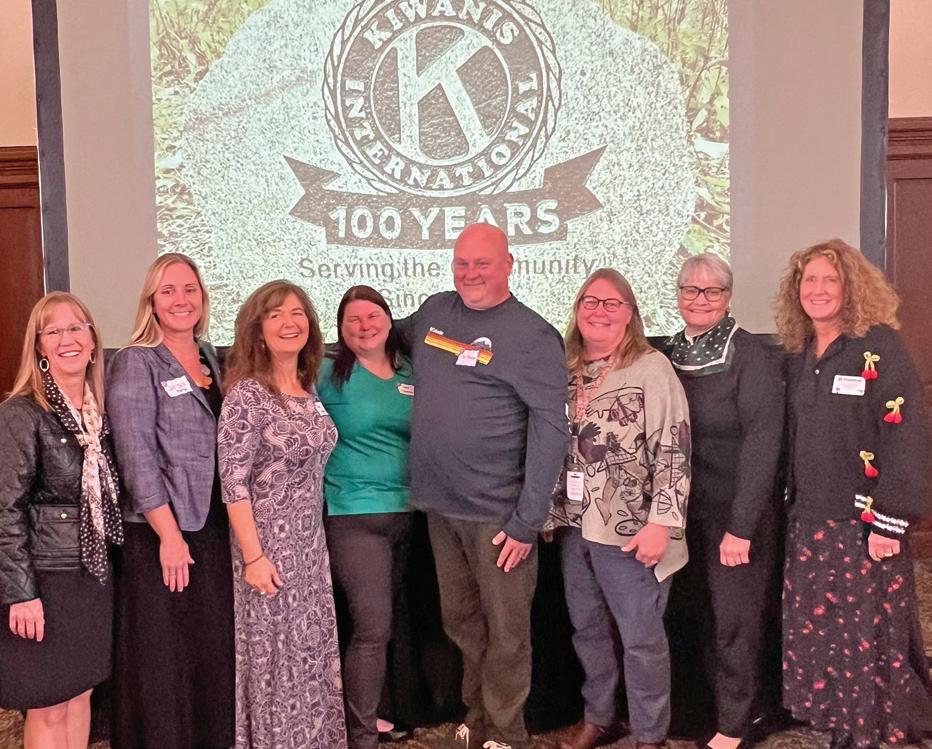
100th anniversary celebration of the local
Chapter of Kiwanis at Kirkbride Hall included the following offi-
and guest speakers: Ellen Jabour, past president, Kiwanis Club of Traverse City; Jill Sill, executive director, Norte’ Youth Cycling; Kara Gregory, founder, Power Book Bags; Mayor Amy Shamroe; Jim Pearson, executive director, Holiday Hills; Kristin SonnemannGrams, teacher, Traverse Heights; Sue Petrison, 2015-16 president, Kiwanis International; Leisa Eckerle-Hankins, president, Kiwanis Club of Traverse City and VP of Kiwanis Foundation.



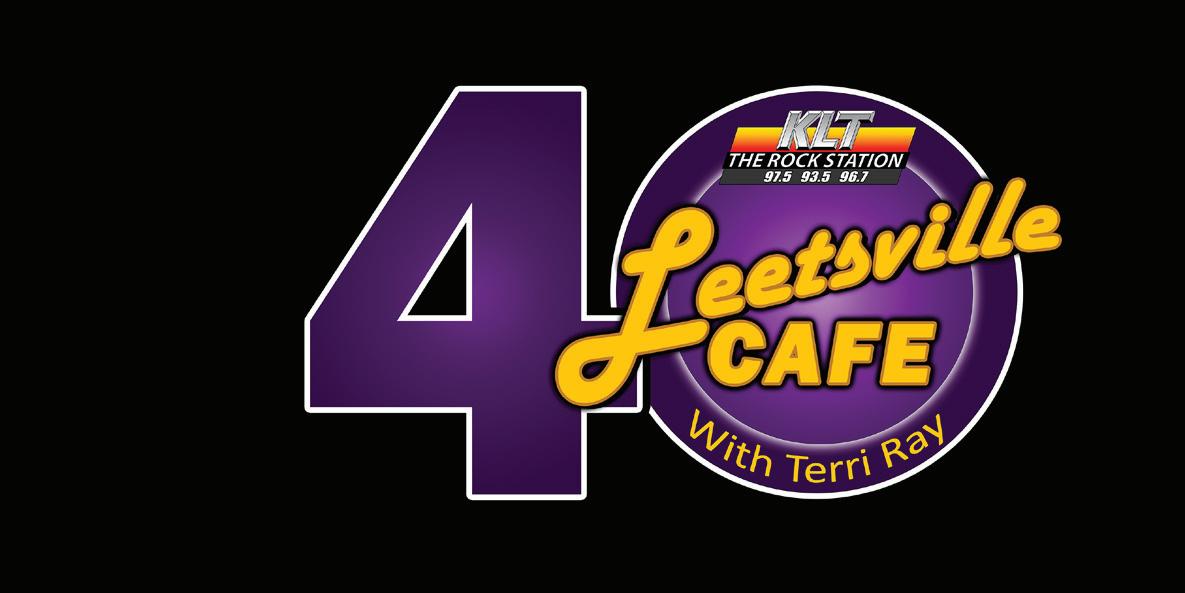













By Beth Milligan
A new tool is in the works that could help bring more housing to Grand Traverse County: a zoning atlas, or an interactive map that compiles zoning rules and parcel data to show where housing can be built (or not) – and where regulations could be changed to encourage more development.
The Grand Traverse County Economic Development Corporation (EDC) recently approved contributing $40,000 toward an $88,000 proposal from Housing North to develop a zoning atlas for Grand Traverse County. The region will be the second pilot area for such a tool after one was recently created covering 85 local jurisdictions in Ottawa, Kent, and Muskegon counties downstate. Michigan is one of 30 states that have begun a coordinated effort to develop a zoning atlas statewide in partnership with the National Zoning Atlas project.
“The rising cost of housing and a broader mismatch between Michigan’s housing stock and housing needs have fostered local, regional, and statewide interest in the need for reform,” according to the Michigan Zoning Atlas website. “There is growing interest in investigating zoning reform, especially to allow for more diverse housing types that can offer more affordable options that are near jobs and amenities. Many communities are realizing they lack the diverse forms of housing needed for today’s populations, but in
many cases policymakers are flying blind: there is no consistent, high-quality data describing the boundaries and details of Michigan’s zoning codes.”
With the EDC’s support, Housing North is partnering with Flywheel Companies, the University of Michigan, and the Michigan Association of Planning to create Grand Traverse County’s zoning atlas. “This will include a database and interactive map of all the housing-related zoning codes in the county,” according to the proposal. “The value of this resource will be a shared understanding among policymakers, lenders, developers, and nonprofits of exactly what types of housing can be built in the county and where it is currently permitted. We can then benchmark our known housing needs against the current state of regulation to determine what changes might be most beneficial to the community.”
Yarrow Brown of Housing North – who is working on securing grant funding to cover the rest of the project budget – says the project will also include digitizing local zoning maps and adding in infrastructure and GIS data, such as showing where wetlands or other natural resources are located. Those layers of information can help reveal bigger-picture patterns, Brown says, such as that a township has its high-density zoning clustered in wetland corridors. “Does that make sense?” she asks. It can also reveal, for instance, that a community’s zoning is overwhelmingly
“If you want to better understand Traverse City’s need for zoning reform, you could get that vision.”
– Yarrow Brown, Executive Director, Housing North
focused on single-family homes, which might be hindering building multi-family apartments, duplexes, or other types of desired diverse housing.
Beyond the zoning atlas, the project also calls for growth corridor mapping and scenario modeling – showing how housing growth could look under the status quo versus under different zoning changes. The mapping will also show “underutilized, vacant, blighted, and functionally obsolete properties along major corridors throughout Grand Traverse County with access to water and sewer infrastructure,” identifying possible sites for redevelopment.

Brown says the zoning atlas and related tools will not only be useful for developers and local leaders, but also for citizens looking to better understanding their community’s zoning.
“If you want to better understand Traverse City’s need for zoning reform, you could get that vision,” she said.
The project is expected to kick off in November and take a year to complete, with public meetings planned along the way to engage residents in the process and teach them on how to use the final product.
“It’ll be developed collaboratively,” Brown said. “We want to hit the ground running as soon as possible.”






ENERGY/ UTILITIES/ ENGINEERING

By Craig Manning
Who is the biggest power consumer in the City of Traverse City? We bet your first five guesses are wrong.
Tucked into a business park next to Cherry Capital Airport, Century LLC looks relatively unassuming from the outside – or, at least, as unassuming as a company headquartered on a 13-acre campus can look. It certainly doesn’t scan as the type of business that could, all by itself, account for 7% of Traverse City Light & Power’s total energy output.
But according to Century President Tim Healy, Century is exactly that type of business. In fact, not only is this precision
manufacturing firm TCLP’s single biggest power user, it could also burn through a whole lot more of the local utility’s output if it weren’t being cautious and deliberate about its operational rhythms.
For those who are unfamiliar, Century is a two-pronged manufacturing company that has been operating in Traverse City for decades. The company uses its precision machining and heat-treating capabilities to manufacture key components for industries like automotive, aerospace, defense, mining and energy. According to its website, Century has customers in 43 states, three Canadian provinces and 16 other countries.
Century’s global, high-demand status
in the manufacturing world is due largely to its state-of-the-art heat-treating systems – specifically, a liquid molten salt bath hardening line that can fully immerse parts as long as 110 feet in some of the most rigorous heat-treating environments on Earth. That custom system is ideal for treating and hardening long and unwieldy parts that might pose challenges for other manufacturers, like helicopter rotor masts or other large aircraft parts. Submersing these kinds of components in molten salts changes the molecular structure of the metal and strengthens it, lending greater durability over time.
Century’s heat-treating system spans dozens of furnaces. Those furnaces de-
mand huge amounts of power to operate, hence Century’s status as TCLP’s single biggest customer.
It’s not lost on Healy that using a lot of energy isn’t exactly a badge of honor for a business in the year 2024. He says Century has been looking for ways to become more energy-conscious – to the point where the business even looked into installing a two-megawatt solar array on its campus. The findings weren’t promising.
“At the time we looked at it, the payback was something like 50 years,” Healy says of the solar farm idea. “And that was if everything went perfect. It just wasn’t feasible for us, given that we don’t know
anything about how to generate power and distribute it. We decided there was a better option for us, which was to become a better user of power, rather than trying to become a producer of power.”
Now, Century is in the midst of an ambitious project to become the most conscientious power customer it can be. Rather than trying to slash its overall power usage considerably – essentially an impossibility, Healy says, given the nature of the work Century actually does – the company is trying to smooth out its consumption so that it isn’t spiking the power grid in potentially dangerous ways.
“Of course, the total consumption of energy is an important metric, but it’s not the only metric,” Healy said. “Another really important metric – and the metric that I would suggest is more important, in terms of our energy grid – is peak demand. How much energy are we pulling at any one time? That’s the thing that causes, as we’ve seen across the country, things like rolling brownouts. As peak demand reaches, and eventually exceeds, the capability of the power generation system to provide that instantaneous amount of electricity, that’s when power companies have to start shutting off service to people.”
While power companies have been increasingly vocal about peak demand in recent years – to the point of asking customers to minimize power use at peak hours of the day – most customers can’t push the power grid into the danger zone all by themselves. As TCLP’s biggest user,

Century also has the distinction of being the rare exception to that rule.
“If we spike the system – and when I say ‘spike,’ I mean increase our demand significantly at any given time – we can be a big driver of that peak demand,” Healy said. “When you’re already accounting for 7% of all the electricity consumption, if I were to double at any one time, I’m creating a pretty big spike to the system.”
In fact, if Century were to ramp up all its furnaces at the same time, Healy says the manufacturer could consume some 20-25% of the power TCLP is producing. Rather than risk getting anywhere near that level, the company’s goal is to move things in the opposite direction.
“Our goal is to reduce our peak demand by 16%, which is pretty significant when you look at how big we are to
TCLP,” Healy said.
In pursuit of that goal, Century has purchased a new automation system, which has involved installing control cards on every furnace system in the company’s arsenal.
“Each control card is connected to a central controller, and if the overall demand starts to spike, the machine will go back to the controller on each furnace, and it will modulate that so that
Do you need care for your brain, spine, or nerve condition? The Munson Neurosciences Team is committed to providing excellent care close to home. Subspecialties include:
• Brain and Spine Injuries
• Epilepsy and Stroke
• Brain Tumors
• Neuropathy and Nerve Pain
• Migraines and Chronic Headaches Now Accepting New Patients!
• Pain Management Procedures
Visit munsonhealthcare.org/neurosciences or scan the QR code to learn more.


we increase our power usage much more smoothly, or spread it out over a longer period of time to try to get rid of those peaks,” Healy said. “The system entails a lot of controllers installed into a lot of different machines, plus a central processing system, and then it has to be connected to TCLP’s power supply system so that we’re all looking at the same information.”
The system is big and complex, and installing it and connecting it to the grid has taken most of this year. Now, though, Healy says Century is in the last stage of the process: refining everything so that the system effectively spreads peak energy demands across all its furnaces during operations.
ing of electricity through the Midwest. Coal is cheap, and as coal comes offline, electricity gets more expensive. That’s part of it. Another part of it was just general inflation. But then our second question was, ‘How do we mitigate these costs?’ And that led us to peak demand, and to this management system that will hopefully help us keep our rate low and be a better citizen on the grid.”
“Electricity is already our number one cost. When your top cost doubles, it gets your attention.”
– Tim Healy, President, Century LLC
If all goes according to plan, the manufacturer’s power usage patterns in 2025 should look considerably different than 2024’s numbers – and considerably healthier for the grid.
With that shift, Century is also eyeing big monetary savings in the New Year. Spiking the grid, especially at peak usage hours, yields a penalty of higher energy bills. That’s always been the case, but Healy says recent nationwide increases in energy costs made the monetary consequences of a grid spike that much more severe – particularly for a user as big as Century.
“It was our electricity bill doubling,” Healy said when asked what first motivated Century to install the control card system. “Electricity is already our number one cost. When your top cost doubles, it gets your attention. So, first, that got us asking, ‘Why is our bill up?’ And essentially, it comes down to a change in the sourc-
According to Healy, the new system is just part of a broader initiative within Century to become a more responsible user of the power grid – something he hopes other local businesses will pay attention to as energy needs continue to evolve and change in the years and decades to come.
“We’ve changed our operational patterns of when we run some of our systems, because we’re trying to run at the times that are most favorable for TCLP,” Healy explained. “But we also recognize that, in our community, our patterns might change, too. There’s a likelihood, as we get more electric vehicles, that peak demand hours will flip. If everybody’s charging their electric vehicles at night, we might not have peak demand at noon or 2pm; it might be 2am instead. Thanks to the work we’ve done this year, we now have the ability to change our operating patterns – what we run, when we run it, and how that allows us to fit into TCLP’s best operating space. And what all of this does, at the end of the day, is it buys TCLP time and flexibility, so they can make the right decisions for their power generation needs.”

Our team focuses on preventative care and health management by developing long-term relationships with our patients. We want the best overall health possible for you and your family.


We’re looking for qualified staff to join our growing practice. Visit our website to learn more about positions available and the benefits of working in our family-oriented, quality care organization in beautiful Traverse City, Michigan.

4290 Copper Ridge Dr, Suite 200, Traverse City, MI 49684 www.westfrontprimarycare.com 231.935.8930

Working to make tomorrow safer.
Tomorrow is on.
The Great Lakes are a vital source of water, life and play for all of Michigan. That’s why we’re committed to their safety and environmental protection. With the Great Lakes Tunnel Project we're taking extra precautions in the Straits, making a safe pipeline even safer. Placing Line 5 within the Great Lakes Tunnel will eliminate any risk of an anchor strike.
While the tunnel is being built, we’ve added additional safety measures—including hi-def cameras and a marine monitoring/alert system— at our 24/7 Maritimes Operation Center. Safety in the Straits is our top priority. We’re committed to keeping the Great Lakes safe for generations to come.
Learn more at enbridge.com/line5tunnel.



While market volatility can be painful, it can remind investors of the importance of sticking to the fundamentals.
Transitioning your family business to your heirs may sound simple enough, but in fact, doing it successfully can prove difficult. To help improve your transition’s chances for success, consider family business governance.
Market volatility, painful as it can be, can actually provide an important lesson for investors about why it’s important to stick to the fundamentals, such as having an asset allocation strategy and reviewing your plan. With that in mind, here are suggestions for turbulent times that may help you turn today’s worries into tomorrow’s good habits.
This is a system of correlated tools and actions to support the next generation with controlling, owning, and operating the business. It also puts in place a framework that contains business protocols, describes how future ownership changes occur, and establishes a precedent for making business decisions.
Remembering asset allocation
When market volatility occurs, investors have the opportunity to get back to fundamentals they may have forgotten. This is especially true for asset allocation — the strategy financial professionals return to time and again when investors want help dealing with volatile markets.
There are several tools that can be employed as part of a family business governance system, including:
A buy-sell agreement is a legally binding contract that stipulates how an owner’s share of a business may be reassigned if triggering events occur, the price that will be paid, and the payment structure.
At its most basic level, asset allocation is how you diversify your investments across different asset classes (stocks, bonds, cash alternatives, etc.). This varies based on a number of factors, primarily:
• What you want your investments to help you achieve (objectives)
• How comfortable you are with market volatility (risk tolerance)
• How long it will be before you will need to access your investments (time horizon)
The asset allocation model that best suits any given investor depends on where they land in regard to these three factors.
A family employment policy document can be kept within the family for private use or incorporated into the business’s human resource documentation. It sets expectations for heirs, spouses, and extended family members about such issues as how they can obtain employment in the business, the requirements to attain key positions, the compensation standards to be used, and incentive language for family members.

A distribution or dividend policy is key in setting expectations with family members regarding what distributions they should expect to receive from the business. Business owners must balance the need for cash to maintain or grow the business with the desire to receive distributions.
It’s important to remember that asset allocation offers investors a trade-off. During good times, a diversified portfolio’s return will lag the best performing asset class. On the other hand, during down periods, it will do better than the worst performing asset class. It’s up to each investor to decide what’s more important — participating more in the good times by holding more stock or avoiding the worst of the bad by holding less.
A professional board of directors is a governing body that helps oversee the business and makes major decisions. A board generally comprises three, five, or seven professionals from various industries that have the subject matter expertise to assist the company strategically.
Reviewing your plan regularly
If you have an asset allocation plan and still find yourself lying awake at night, volatility is a chance to revisit your plan for possible adjustments.
A family board or council is a group within the family — or may include the entire family — that comes together to make decisions about the business on the family’s behalf.
A company mission statement can be valuable to your employees and your family as it addresses the business’s purpose and vision and can help guide future company leaders.
Your estate plan can address ownership, control, distributions, and several other factors.
The business’s governing documents should be reviewed at the same time the family business governance system and tools are put in place. Revisions to these documents or corporate resolutions stored in the corporate minutes may be needed to align these documents with the company’s governance system.
Helping ensure a successful transition
It’s possible you overestimated your risk tolerance when creating your plan. Due to their potential for providing growth and, sometimes, income, stocks have an important role to play in many plans. But with that potential comes the likelihood for greater price volatility than is typically seen with other investments, such as bonds. If concern about your investments when there’s volatility causes you stress, it may be time to see whether you need to scale back the amount you have allocated to stocks. It’s also possible the problem is not with your plan. Over time, market activity can shift your allocations away from your plan’s targeted amounts. Say you started with a hypothetical 60% stocks/40% bonds portfolio. An extended rise in the stock market could shift it to, for example, 75% stocks/25% bonds. As a result, when there’s market volatility, you would experience more of it than intended. You may want to consider rebalancing your portfolio regularly. Rebalancing is simply checking your investments to see whether market activity has caused them to drift. If they have, you can decide if you want to sell investments that have increased in value and use the proceeds to buy others that may have decreased. Doing this at least once a year — or allowing your investment platform to do it for you — can keep your allocations, and risk level, where you want them.
Transitioning the family business to the next generation is much more than transitioning shares. A well-thought-out and documented plan that addresses ownership, control, and operations helps build a strong governance system for your business. This system, combined with communication with the next generation, can be key to helping ensure your transition’s success.

JULIAN | BLACK
Wealth Management Group of Wells Fargo Advisors













By Craig Manning
“We aren’t a good state for renewables.”
If you were in attendance at the Northern Michigan Manufacturing Summit this past spring, you might recall hearing those words from Zach Anderson, chief operating officer of the Wolverine Power Cooperative, as part of a panel conversation about energy.
While Anderson doesn’t mince words about the challenges to renewable energy implementation in Michigan, he’s also one of the state’s loudest clean energy advocates.
Headquartered in Cadillac, Wolverine Power is owned by seven member cooperatives throughout the state, one of which is Traverse City’s Cherryland Electric Cooperative. As Anderson explains it, Wolverine’s job is to serve as the “wholesale power provider” to its seven members,
all of which are “distribution co-ops.”
“So, our responsibility is to generate or purchase generation, and then transmit that power via the transmission network
ing Station in southwest Michigan. That plant closed in 2022, but Gov. Gretchen Whitmer helped spearhead a campaign to reopen the station, citing its benefits
“As Michiganders, we love the Great Lakes that surround us, but they put Michigan on a peninsula, and from an electricity perspective, that is a huge isolating factor.”
– Zach Anderson, Chief Operating Officer, Wolverine Power Cooperative
to our retail distribution substations,” Anderson said. “Then, our members take (the energy) to the homes and businesses that they serve.”
Recently, Wolverine has been in the news for its commitment to buy the lion’s share of the energy produced by the soonto-be-rebooted Palisades Nuclear Generat-
for grid reliability, the state’s ambitious carbon-free energy goals, and more.
Last September, Wolverine signed a power purchase agreement with Holtec International, the enterprise that owns Palisades, to purchase up to two-thirds of the power generated by the 800-megawatt plant. Now, Anderson says Palisades is
on track to reopen by late 2025 or early 2026. It will be the first time in American history that a shuttered nuclear plant has been brought back online.
Even before the Palisades agreement, Wolverine had a long history of betting on alternative energy. In 2007, when the state’s first commercial-scale wind farm came online – the Harvest Wind Farm in Huron County – Wolverine signed a 20year agreement to purchase all the energy produced there. Additional investments in wind and solar followed.
Earlier this year, Wolverine announced that it is “on track” to achieve 100% carbon-free energy by 2030, 10 years ahead of Michigan’s 2040 target.
Much of that energy will come from the Palisades plant, though Cherryland Executive Director Rachel Johnson said this spring that Wolverine already had a 60% carbon-free portfolio in 2024, including

20% from renewables.
“We will be the first utility in the state (to be 100% carbon-free) and amongst the first in the nation, especially at our size,” Anderson told the TCBN. “That’s a really big lift – a monumental lift – and we obviously couldn’t do it without the addition of the Palisades nuclear plant. But it’s important to note that we also couldn’t do it without the wind portfolio we have today.”
Is there any contradiction in Anderson’s statements about the value of wind energy to Wolverine’s bottom line and his earlier insistence that Michigan, as a state,

is not conducive to renewable energy? He certainly doesn’t think so.
On the contrary, Anderson insists that Michigan’s barriers to renewable generation don’t give it a pass to ignore renewables. Instead, he says the state should actually be working harder than others to build up its renewable infrastructure and defeat those barriers.
What are those barriers, exactly? A big one is the weather – particularly in the winter, when short, cloudy days are the norm and sunny days are the (rare) exception. Add in snow and Anderson says Michigan’s winters alone make the state











“not a great location for solar.”
“Solar is the best in the desert –Southwest Arizona and places like that,” Anderson says. “But even states just to our south, like Indiana, Illinois and Ohio, they’re a little flatter, they’re a little bit more open, and they get, frankly, quite a bit more sun than we do here. So, we’re not the best for solar.”
Anderson says that from a wind standpoint, Michigan is a “little bit better,” but the wind doesn’t blow as hard here as it does out on the plains.
“South Dakota, North Dakota, Nebraska, Iowa, Minnesota – those are states that
get much more wind than we have to deal with here in Michigan,” he said. “I personally think that’s great for actually living here, but it’s not great from a renewable standpoint.”
The third barrier is one that affects all power generation, renewable or not.
“As Michiganders, we love the Great Lakes that surround us, but they put Michigan on a peninsula, and from an electricity perspective, that is a huge isolating factor,” Anderson said. “When we talk about needing new transmission coming into the state, it’s not as easy as just running lines north, south, east, and
west, like many other states that surround us in the upper Midwest can do.”
Given Michigan’s challenges, Anderson says it will be exceptionally difficult for the state to “run the grid with renewables alone” – perhaps ever, but at least for the foreseeable future. Still, he says renewables can be a “great” complement to the portfolio – especially as investment in battery storage makes it more feasible to harness energy from Michigan’s (many) windy and sunny times and literally save it for a rainy day.
“What we need to be doing is balancing reliability with decarbonization,” Anderson reasoned. “Renewables should absolutely be a part of that mix, because when the sun is shining or the wind is blowing, you’ve got quote-unquote free fuel out there. But that also has to be balanced with something, and so for us, that ‘something’ comes down to nuclear. Nuclear is going to play a huge role in providing the 24/7 baseload supply that we need to keep the lights on. And, in addition to that, until batteries can get us through the hottest of the hot and the coldest of the cold days, natural gas is also going to be part of the mix for the broader grid to keep the lights on. So, for Wolverine, the focus right now is really on not putting all of our eggs in one basket.”
Ideally, Anderson says the diversification philosophy would also mean enhanc-
ing the energy “transmission superhighways” that flow in and out of Michigan from other states. If those connections were better, he explains, Michigan’s renewable energy barriers wouldn’t be such a big deal.
“It might be sunny in Wisconsin today and cloudy in Michigan, and if they’ve got excess solar, they can transport it to Michigan,” Anderson explained. “If Michigan is sunny and Wisconsin is cloudy, we can share that solar energy back and forth. Having those transmission superhighways between neighboring states, where weather patterns may be different a few hundred miles away, is really, really important in that diversity strategy. In the energy world, we know we have to have something that’s online and loaded all the time. Nuclear can help fill that gap, but we also have to have transmission connectivity between neighboring states to help balance out the weather and to have a diverse number of resources to make sure affordable and reliable energy is available 24/7, 365.”
Some of those connections exist already – power lines that pass over Michigan’s southern border from states like Ohio and Indiana. But Wolverine is also proposing a project called the “Lake Michigan Connector,” which would essentially run power cables under Lake Michigan to connect Michigan and Wisconsin.

“The technology we’re proposing is controllable, which means we can send power to our neighbors when we have access, and they can send power to us when they have access,” Anderson says of the Lake Michigan Connector. “We can do this safely on the bed of Lake Michigan. It’s not a risk to the to the lake in any way, shape, or form. And it also solves one of the big challenges as we’re looking to bring new transmission into the state, which is figuring out where you are going to site these power lines. Because large transmission requires a lot of land, and landowners don’t want to see new transmission towers come through their property. Going underwater, you don’t have that problem.”
Anderson says there is a precedent for this type of transmission line in Michigan, running parallel to the Mackinac Bridge between the Upper Peninsula and the Lower Peninsula.
“That line is not as robust as what we’re proposing, but it’s there,” Anderson said. “What we’re proposing also looks a lot more like what they do in Europe all of the time, sharing power between some of the island countries and the broader land mass in the continent of Europe. So, this is a technology that’s proven. It works, and it can be done safely. It’s not as widely used in the U.S. But, as we’ve already discussed, there aren’t lot of states like Michigan, where we have water surrounding us on all sides.”












We are thrilled to announce that we have been ranked #1 in Member Satisfaction Among Commercial Health Plans in Michigan and swept all eight dimensions in the 2024 J.D. Power Study. This is a testament to our unwavering commitment to our members and the communities we serve. #1 in Member Satisfaction Among Commercial Health Plans in Michigan
ready to help serve our members.

By Art Bukowski
Bob Mannes is an oil and gas man at heart. It’s in his blood, dating back to when his grandfather ran a gas station near Holland and prospected for oil in his spare time.
And while some are quick to criticize the broader oil and gas industry for its role in climate change, Mannes runs a company that sequesters millions of tons of carbon as it produces oil. It’s a rare operation (the only of its kind east of the Mississippi River) that Mannes is always eager to talk about.
“As I like to tell people, we’ve been capturing carbon long before it was cool,” Mannes said.
Mannes is the president and CEO of Core Energy, a Traverse City-based company that produces oil throughout northern Michigan. It does this primarily through a method called carbon dioxide (CO2) enhanced oil recovery (EOR), in which CO2 is injected into
wells in order to extract more oil. Once it’s served its purpose, the CO2 is sealed underground and left there.
“We’ve sequestered about four and a half million tons of carbon since we started,” Mannes said.
Mannes is a Holland, Michigan native who grew up in the industry, as his father before him did.
“I went to school to Calvin College to become a petroleum engineer, but calculus did its job and redirected my life away from engineering and into business and communication,” he said.
After working for other operations in the area, he launched Core in 2003 to take advantage of CO2 EOR, which had been pioneered in Michigan by a small group of entrepreneurs who saw the technology in use out in Texas. They didn’t have a lot of success due to low oil prices in the late ‘90s, but
Mannes was convinced he could make it work from a business standpoint.
Mannes uses the analogy of a bottle of Coke that you shake up and sit on a desk. The built-up pressure blasts the pop everywhere when you take off the cap, but at some point, the pressure in the system is depleted and the remaining pop just sits there in the bottle.
“Now the problem is that the bottle’s done fizzing, and that oil is dead. There’s no energy. You need energy to produce that oil, and energy is very expensive when you need to man-make it. That’s where the CO2 comes in. You inject it and it helps… increase the pressure and jostle it out.”
CO2 is just one of many EOR techniques, all of which are focused on finding better ways to extract oil from wells after pumping and other conventional methods are exhausted.
“By the time (conventional methods) are done, on average you’ve only recovered 20 percent, maybe 25 percent of the oil that’s in place,” Mannes said.
“So you’ve got four times as much oil left down there as what came out.”
Core now has 13 wells using CO2 EOR and is working on more.
“In Otsego County, we’ve produced about four and a half million barrels of oil outside of Gaylord that would never had been produced had it not been for CO2 going in the ground,” he said. “That’s a huge positive for the economy out there. The jobs, the landowner (income), the taxes.”
So where does the CO2 come from?
Thousands of operations are extracting natural gas out of what’s known as the Antrim Shale, a rich deposit that stretches in a wide band across northern Michigan. CO2 exists within this natural gas as contaminant, and a plant near Gaylord run by Phillips 66 separates the CO2 from natural gas supplied from more than 9,000 wells before it can be sold for use. Core captures north of 80 percent of this CO2 that would otherwise be vented and uses it in nearby wells.
Core’s ability to take the CO2 and use it very close to the source is a big reason why it’s the only commercial CO2 EOR operation east of the Mississippi River. When the technique was first derived out west it proved to be very effective, but it ultimately only pencils out where sources of pure CO2 are close to the oil wells where it will be used. Geologic factors also contribute, as not all mixes of sediment and rock are suited for the process.
“It just doesn’t work everywhere,” Mannes said.
It’s important to clarify that CO2 EOR is not hydraulic fracturing (commonly known as “fracking”), though they share some similarities.
“In the simplest sense, fracking is high pressure and high volume on the injection side. You’re trying to put a lot of stuff in there at a really high pressure to create fissures in the rock so that hydrocarbon can come back up,” Mannes said. “Our operations are low pressure and low volume, and we’re injecting a solvent into existing… space. We don’t have to create any.”
Mannes points to his company’s track record as evidence that the technology is proven, dependable and safe.
“We’ve been doing this safely and securely for over 20 years,” Mannes said. Core produces about 1,300 barrels of oil a day, good for 475,000 bar-
rels a year. It’s sold almost entirely to GulfMark Energy, one of the largest purchasers of Michigan crude oil. Mannes is proud of the “great group of people” who work there (about 20, though there are many, many more contractors) and the culture they’ve built over the years.
“People don’t quit Core,” he said. “We have a real family atmosphere, we care about everybody, and we care about the family behind every employee.”
Mannes is skeptical of various initiatives to move away from oil, citing its proven reliability and importance to the economy. He bristles, for instance, at the state’s current goal of reaching 100 percent carbon neutrality in energy production by 2050.
“I can appreciate the aspirational goal, but when you stop and do the math, you pencil it out, it misses by a mile,” he said.
Such initiatives are putting pressure on major utilities to take sources of reliable energy offline, Mannes says, something that could drive up rates for consumers and might cause significant problems with energy supply in the future.
“I don’t think a good, solid argument can be made against oil and gas because there isn’t anything to replace it.”





he said. “You want electric vehicles? How are you going to make the tires on those cars? How are you going to make all the plastics and all the components? Oil is so intertwined in this society.”
The industry is also extremely important to the state’s economy, Mannes says, particularly in northern Michigan.
“There are thousands of people, literally, that in some way are involved in or impacted, whether it’s electricians, the on-site jobbers, the welders, the drillers, the truck drivers, and the financial contributions (to the economy) are huge, hundreds of millions.”
Finally, Mannes points to the Michigan Natural Resources Trust Fund, which over almost 50 years has granted out more than a billion dollars to purchase land for hundreds of public parks and natural areas across the state. The source of this tremendously transformational fund is money derived from oil and gas leases on state-owned land.
“(Some people) have no idea what this industry’s contributed to the state as they’re enjoying their state parks, enjoying their natural walkways and pathways in the woods,” he said.
Mannes hopes that technology like CO2 EOR can be applied in different ways that can be a “win-win” for both sides of the oil and gas debate. CO2 can be captured from other sources

(including industrial operations), potentially rendering those operations carbon neutral.
“Everybody wants to capture carbon. People on the left are going to want it captured because of their concern over rising CO2 concentrations in the atmosphere and the global climate issues,” Mannes said. “And people on the right and oil companies as such have a use (for that CO2).”



By Art Bukowski
There’s almost too much for gunsmith Delbert “Del” Whitman to love as he settles into another job in his rural workshop near Lake Ann.
Even a short time spent with Whitman reveals a man with a zen-like connection to every aspect of this craft, from its history (he may go off on a tangent about the working conditions for young gunmaking apprentices in early 20th century Britain, for example, or the way archaic patent laws led to multiple permutations of the same firing mechanisms) to the ins and outs of how woodworking and metallurgy have matured over the years.
“One of the really interesting things about my work is I get to see firsthand a lot of those older guns that show some of the evolutionary changes of how guns came to be,” he said. “The (shotguns) we see today are basically the end result of 250 years of evolution and change.”
Then there’s the art. The melding of gorgeous blued steel and sturdy English walnut. The intricate engravings and
lively, dancing patinas on certain models. The deep appreciation for techniques and skills that are in danger of becoming functionally extinct.
“I love impressionist paintings, but you just sit there and look at them,” he said.
While he completes repairs, restorations and other relatively basic work, he’s known across the country for custom gun-fitting. This means he alters or completely builds various components – particularly the wooden stocks – so the gun is
“I get guys who fly into the Traverse City airport all the time or that drive up to see me. These are usually people who are either competitive shooters or very serious upland hunters.”
– Del Whitman, Owner, DC Whitman Custom Gunsmithing
“Here you have something that’s not only absolutely beautiful, but it’s functional. And function is always going to be paramount, but it’s hard to not appreciate the beauty of these things…they’re little works of art.”
While there are thousands of gunsmiths in the country, there are only a handful that do what Whitman does.
a perfect physical fit for its owner.
“I really like helping clients be as successful as they can and enjoy themselves, and a big part of hunting is your equipment,” he said. “Gun fit means the gun is tailored specifically to you, just like a suit, so when you mount the gun properly, you’re 100% aligned with the line of sight.”
He works almost exclusively on shotguns used for upland bird hunting (think pheasants, quail and the like), and does very little rifle or handgun work. He’s well-respected enough to work on collectible guns worth north of $100,000, and high-end hunting operations around the country bring him in to work with their clients. He also attracts many clients of all stripes to northern Michigan.
“I get guys who fly into the Traverse City airport all the time or that drive up to see me,” he said. “These are usually people who are either competitive shooters or very serious upland hunters.”
Born for this
Whitman grew up in Olivia, Minnesota, where his dad was an industrial arts teacher at the local high school. Formative years among the lathes and welding torches gave him the lifelong itch to tinker, build and repair.
“I grew up in that environment,” he said. “I don’t even know what it’s like to not be in a shop working on stuff.”

He also grew up immersed in the outdoors in a hunting and fishing family, competitively shooting shotguns by age 13 and gaining a deep enjoyment for bird and other hunting.
Whitman went on to get a gunsmithing degree from Pine Technical College, a Minnesota school known for training in a variety of highly specialized vocations like taxidermy and locksmithing. After some time spent in California, he decided to relocate to northern Michigan after a visit here. D.C. Whitman Custom Gunsmithing officially launched in 2001.
A big part of the reason he’s excellent at what he does, he says, is that he’s completely immersed in the sport of shooting itself. The best way to apply the science and art of his work is to get out there and shoot, then take those experiences back to the shop.
“To really be good at this, you have to love it. It has to be a lifestyle,” he said. “I still recreationally shoot professional levels of sporting clays. I hunt incessantly because I love it.”
He also takes a great deal of pride in continuing the legacy of those that came before him. While gunsmithing will always survive, those with his talents and depths of knowledge are a dying breed.
“One of the scary things to me is I’m the youngest guy I know that does this proficiency and I’m 47 years old,” he said. “There’s just not very many of us.”
Whitman’s shop oozes with character, the kind even pictures can’t adequately capture. It’s here where the magic happens, and for many years most of that magic was repairs, renovations or custom work. But over the past five or so years he’s leaned heavily into expanding his fitting business.
“I kind of decided that I had a big enough client base, and I really wanted
to get away from the piddly restoration stuff that isn’t very high margin and … pivot toward doing more fitting,” he said.
Ultimately, this work allows a client to become one with the gun in a way that’s not possible without a custom fit. A well-executive fitting facilitates instinctive, fluid movements that greatly improve success in the field or on the shooting range.
“It’s much like golf or martial arts or instinctive archery where you don’t really actively aim the gun, you get to the point where your body’s just doing it,” he said. “The gun gets you and you focus on the target.”
And fitting makes sense, he says, when you consider the very wide variations in the human body.
“Just grab five random people off the street and see how different they are. And under the American philosophy, guns were mass produced and everybody was expected to alter to them,” he said.
“So it’s almost like Americans have a different philosophy on how to shoot because we’re always altering and having to aim, and you can’t have that thoughtless, dynamic shooting style.”
For this process he built a fully articulated “try-gun” that he uses to gather nine data points from his clients, and from there he either modifies their stocks or builds a complete custom gun. Many clients subsequently send all of their guns to Whitman for this work and maintain a working relationship that lasts a lifetime.
For now, Whitman will continue to toil away and do the best work he can from his headquarters in the heart of northern Michigan.
“One of the things my dad and college instructor instilled in me is that the first thing you have to do is educate yourself on what makes quality work,” he says.
“If all you ever focus on is maintaining the quality of your work, everything else should come.”




Novello Specialty Clinic warmly welcomes Dr. Amanda Porter, Mayo Clinic trained Neurologist, to our growing Neurology department.
















By Kierstin Gunsberg
For Harbor Springs-based entrepreneur Eva Oldman, founding the clothing brand Niibiishenh has been about more than just filling a market gap – it’s also about giving her two young children hands-on business experience.
Launched in 2023, Niibiishenh is “Native owned and Native designed children’s clothing for all kids,” Oldman said.
Featuring colorful hoodies, tees, pajamas, and more, she says she was inspired to create the brand because Native children have few places to shop for clothing that “represents who they are.”
Oldman’s own grade school-aged children, Niibiishenh and Mookse, are not only the inspiration behind Niibiishenh’s designs, they also actively participate in the creative process.
“It starts with a little brainstorming session,” she explained.
For their “Pow Wow Unicorn” design – a hot pink unicorn leaping through clouds –her daughter took the lead, guiding Oldman (a graphic designer) through multiple drafts until the design was perfect.
“I’ll just start my draft out and then I’ll show her, and then she’ll add in what she wants,” Oldman shared. “Like, ‘I want rainbow hair for the unicorn,’ or ‘I want pink this or pink that.’”
While most designers finalize projects through emails and formal meetings, Oldman’s finalization with her daughter is a bit different.
“She’ll say, ‘Oh my gosh, I love it,’ and then she’ll give me a hug, and the design is done,” she said.
Since launching as both an online and pop-up store in 2023, the brand’s sales have grown 40%. Oldman and her children manage nearly 24 pop-ups annually, setting up at Pow Wows and other events across the state.
“They’re gaining a lot of skills they can use in the future as young entrepreneurs,” Oldman said. “They’re just gaining a lot of knowledge about running a business.”

Her kids are also getting a crash course in business economics by helping with the pop-up events, which account for 60% of Niibiishenh’s annual sales. Afterward they often ask, “Did we make enough money?” If the answer is yes, Oldman takes them to the store to spend some of their earnings.
“So they’re learning that commerce sense,” she said.
As for how Niibiishenh is reaching its audience, Oldman – who also runs the adult clothing brand Graphics by Eva – said most of her marketing happens through social media, word of mouth, and in-person networking at her Petoskey barbershop, Faded Barber Studio.
Looking ahead, Oldman plans for Niibiishenh’s product lines to grow along with her children.
“As they grow, this clothing line will grow with them,” she explained, adding that their newest product will be a purse featuring the Pow Wow Unicorn design.
“When they become teenagers, they’re going to be designing clothing for teenagers, thinking about what that target market likes and gearing toward that market,” she said. Visit the online shop at niibiishenh.com
20Fathoms sponsors this column. Designated by the Michigan Economic Development Corporation as the Small Business Support Hub for Northwest Michigan, 20Fathoms is a nonprofit organization providing critical services for the region’s entrepreneurs. It specializes in accelerating the growth of innovative and scalable startups. Learn more at 20Fathoms.org.

On your entrepreneurial journey, the road is paved with dreams, grit and determination. We help simplify the complex so you can focus on the results.
Our business is to help your business succeed.
Let’s grow together.

it’s because of the area growing.
on a massive summer and some surprising findings about his passengers.
TCBN: We haven’t caught up since the busy summer season. How did it turn out?
Klein: Summer was really great from a passenger perspective. We saw records in June, July and August. Our overall passengers for the year are up about 11%. We beat our records by only a few thousand in June, but in July, we had 124,000 passengers versus the previous record of 112,000. In August the previous record was 106,000 and we hit 118,000. So very, very solid for us. And September was another great month; we had 70,470 passengers versus the previous record of 66,800.
TCBN: Those big increases are so hard to sustain year after year and so, so rare for airports today.
Klein: We count our blessings. If you go back to 2018, we’re up around 40% in passenger numbers. And there just are not any airports anywhere that can say that, except maybe Sarasota. When we announced our year-round Charlotte service, we ranked number one in the U.S. for percentage of seats being added to a market from July 2024 to January 2025. We added almost 3%, and the next closest was Charlotte at 2.2% The national average is pretty close to zero or no growth. And our Charlotte service going year-round for us is a game changer, especially the schedule. Because it departs at 6am, so it gets you to the southeast but also to the Caribbean. And coming back, you arrive by 10:50pm. What was happening before is people used to have to double-connect or would miss that last connection from Chicago and have to stay overnight.
TCBN: But what’s interesting is you do a wonderful job at the airport, but all this growth isn’t really because of the airport;
Klein: Yes. And it caused us to ask, “Who is flying out of Cherry Capital Airport?” Northern Michigan on average sees about six million tourists a year. Over the last 10-15 years you see that trend fluctuate between 5.5 million and 6.5 million based on the economy. But since 2019, the area has seen around 5.8 million each year. And 97% of those tourists are coming to the area via car. So the airport is only seeing about 3% of those visitors.
TCBN: So where has the growth been?
Klein: We were hearing that hotel occupancies and short-term rentals and restaurants were flat, while we were still seeing major growth. So, why wouldn’t we see the same thing as them? It’s the local community. The airport’s growth has come from those who have relocated here and now call northern Michigan home. The area has grown, and trips from here have grown almost threefold. And we are capturing more people flying from here versus other choices, and we know we are getting more business travelers, with more people parking and more business people focused on those early morning flights.
TCBN: So how does that change your strategy as the airport expands?
Klein: Well, we’ve got to build more of a facility that the local community needs, and that means not only a local feeling, but providing local amenities. And those business travelers look for work spaces for a quick video conference. Wi-Fi becomes even more important. So more amenities to serve those audiences.
TCBN: So interesting. Back to summer for a moment. Were there also challenges this year?
Klein: Yes, we did see some challenges. In mid-July there was that Crowdstrike breach that affected Delta for a few days with delays and cancellations. But the biggest was our
that.
TCBN: Meaning there were times you couldn’t let people into the airport?
Klein: Correct. We had to manage that at certain times of day. We never had to stop anyone, but we were counting, and within single digits of cutting that off at times.
TCBN: And how did the Cherry Festival turn out?
Klein: I love the Cherry Festival, but it was a struggle. The air show negatively impacted 5,000 customers; two aircraft had to wait 1.5 hours and two hours on the ramp due to the airshow. The show had a few other challenges with the Blue Angels and a bird strike and other some operational challenges. But it happened and went fine.
TCBN: So, in terms of the expansion, how set is the overall design?
Klein: In July, we signed a contract to go out for public engagement meetings to ask, “What does community want to see in the airport? What amenities? What services?” So we will conduct several round tables starting in November to get that input. Families want spaces for their kids to play, but seniors might want larger restroom spaces. You might consider quiet areas for people with autism, or mothers’ rooms. Or indoor space for animal relief. Those types of questions.
TCBN: Any early insights into the actual look and feel of the expansion?
Klein: The board wants to keep the prairie, Frank Lloyd Wright style we have now. You see a sort of Up North river feel, and maybe with the expansion we will add add more of a dunes feel, and maybe even the experience of a covered bridge in Leelanau County, the red barn look. We’re at about 30% complete with design.
TCBN: One question that pops up
occasionally is moving the location of airport, which I assume is just a dead idea? Klein: It’s interesting. Going back to when the airport was moved to this site in 1935/36, the community said the airport was so far out of town nobody would ever use it, but here we are today. We saw this in Denver, when the airport was built 35 miles out of town and the town sort of built out to the airport. So anywhere you put it that will happen. It would be a 20-25 year process (to move it), you’d need around 3,000 acres minimum with flatlands, no wetlands and no forests. At today’s prices, the overall cost would be around $5 billion. Then on top of that, you’d have to repay all the grant dollars from the origination of the airport, which would be around $1 billion. And then none of this would be funded by federal grant dollars, so it would be local taxpayers paying for it all. And 45 North, AvFlight, NMC and the Coast Guard would have to move. It just doesn’t make sense. But one thing we can assure community is as we add larger aircraft, they’re newer aircraft, so the noise contours are shrinking inward toward the airport, because newer aircraft are quieter and more efficient with less pollution.
TCBN: Speaking of aircraft, it sounds like there’s a new plane on the horizon you’re excited about.
Klein: Yes, the Airbus 321XLR could eventually be a game-changer for cities like us and Columbus and Indianapolis. It’s extra long-range, so it could take 180-200 people from our size airport to London on 7,000 feet of runway. You’ll see that aircraft in the next three to five years and it will be awesome with all its efficiencies.
TCBN: So amidst all the ‘busy-ness’ your job has changed so much! How does it feel?
Klein: You know, one of the things I’m most proud of is our community has made Cherry Capital ‘their airport.’ They really have, and that makes me very proud.







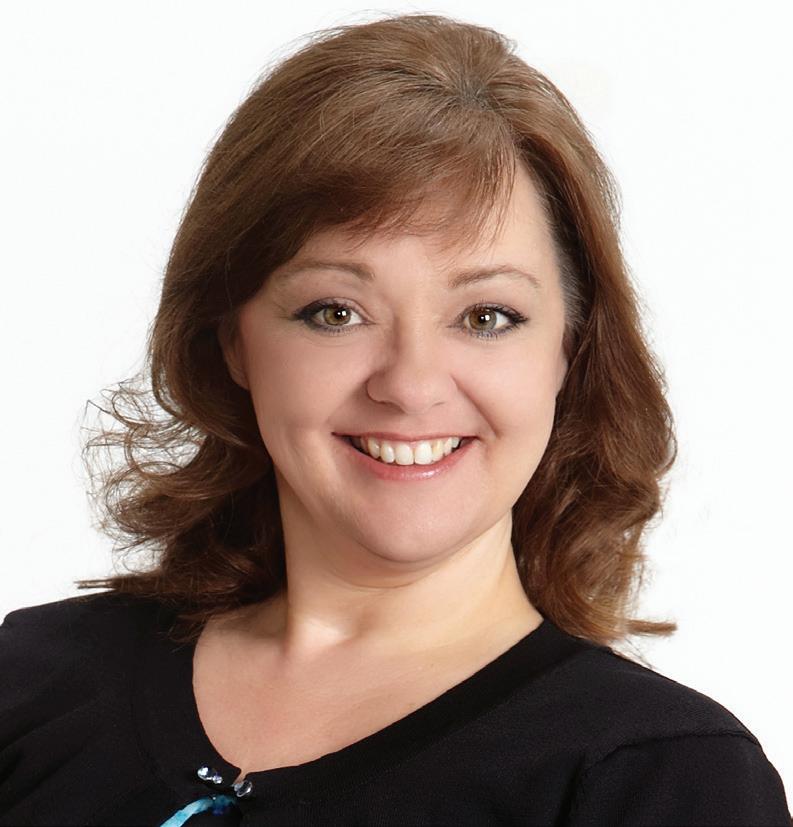




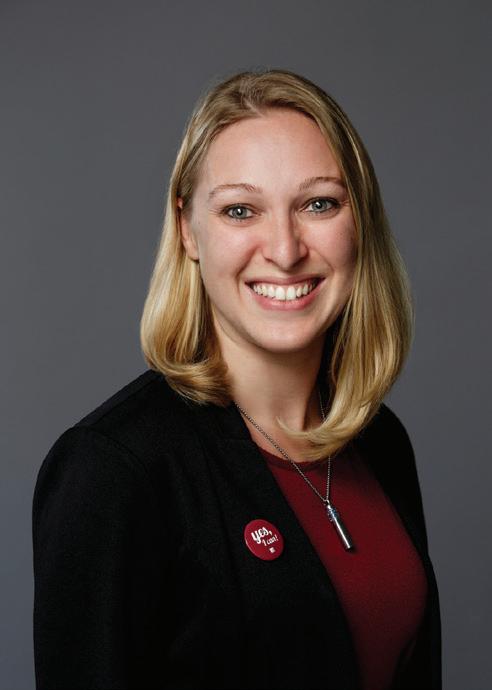


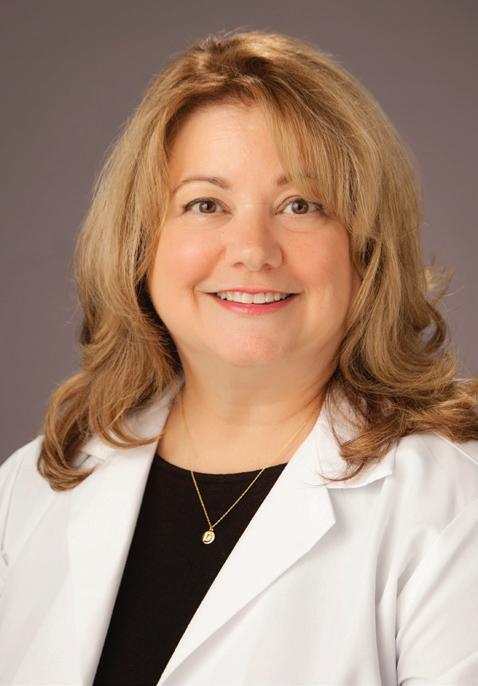




>> BANKING & FINANCIAL SERVICES
1 - Amy Clapham recently joined Black Walnut Wealth Management in Traverse City as a client service associate. Clapham brings 12 years of customer service experience to her new position.
2 - Chris tine Tiesworth has been promoted to wealth management associate at Morgan Stanley’s Wealth Management office in Traverse City. Tiesworth has been with Morgan Stanley Wealth Management since 2009.
3 - Nick VanRyswyk has joined Prout Financial Design in Traverse City, specializing in client account services.
State Savings Bank in Traverse City recently announced the following promotions:
4 - Nancy Buchanan has been named assistant manager at the bank’s Front Street Traverse City office. Buchanan has 12 years of banking experience and has been with the bank since 2020.
5 - Amanda Jorgenson has been promoted to business relationship specialist. Jorgenson brings 18 years of experience to her new position working alongside the commercial lending team. She joined the bank in 2019.
6 - Cyndi La ke is now assistant vice president - retail operations. Lake has been with the bank since 2018 and brings more than two decades of banking experience to her new position overseeing all retail banking operations.
>> HEALTH CARE
Munson Healthcare in Traverse City announces the following personnel news:
7 - Leeda Bashardost, M.D., has joined the Neurocritical Care team, helping to improve outcomes for critically ill and complex neurological patients.
8 - Diana Bischer, nurse practitioner, has joined the gynecology oncology clinical team.
9 - Caitlin Buren, nurse practitioner, has joined the gynecology oncology clinical team. Buren previously worked as a registered nurse before pursuing a focus in women’s health.
10 - Shawna Thomas, nurse practitioner, has joined the clinical team at the Comprehensive Pain Management Program. After 14 years as a registered nurse, Thomas pursued a career as a nurse practitioner.
11 - Sam Bennett has joined TentCraft in Traverse City as its new director of marketing, helping to lead the manufacturer’s next phase of growth.
12 - Maxwell Cameron has joined Grand Traverse County in the new position of community development coordinator. Most recently, Cameron was a project manager with the Detroit Economic Growth Corporation, where he worked on infrastructure, redevelopment, and planning projects in the city of Detroit. He brings extensive experience working with community members, local leaders, developers and small businesses on large community projects to this new role.

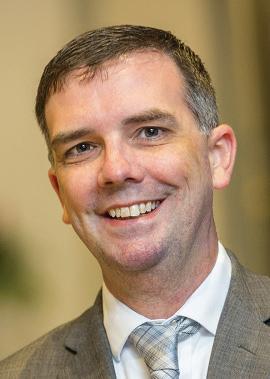

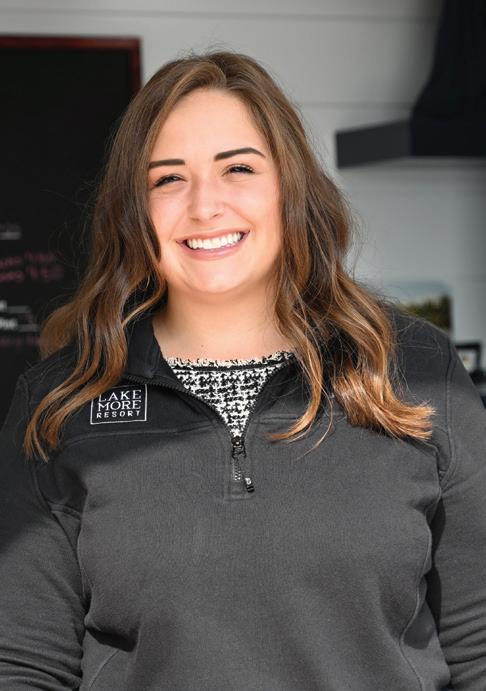

13 - Lynndsay Carlson has joined Bay View Flooring & Design Center in Traverse City as a sales consultant. Carlson brings 20 years of experience in tile and design sales consulting.
14 - Wes Curry has joined the Old Town Playhouse in Traverse City as its artistic director. A new position for the playhouse, the artistic director works in all aspects of a production.
15 - Ashlee Erickson-Trainer has joined Century 21 Northland in Traverse City, specializing in luxury residential sales.
16 - Josh Lyon has been promoted to foreman at Springfield Commercial Roofing and Transport in Kingsley.
17 - Katharine Marvin has been promoted to director of development and alumni relations for the Northwestern Michigan College Foundation in Traverse City. She oversees both the NMC Foundation’s fundraising and alumni relations programs. Marvin joined the NMC Foundation in 2016 as the annual giving specialist and subsequently




served as the director of annual giving and the director of development.
18 - Geoff Rohdy h as joined Williams Chevrolet in Traverse City. Rohdy brings more than 40 years of experience in the auto industry, specializing in sales and acquisition, mostly in the General Motors realm, and is in charge of ordering all Williams Chevrolet’s vehicles.
19 - McKenzie Schwartz has joined Lakemore Resort in Traverse City as assistant general manager. Previously, Schwartz was part of the private client service team at Hagerty.
20 - Connor Vennix has joined Springfield Commercial Roofing and Transport in Kingsley as business development manager.
20Fathoms in Traverse City announces the following:
21 - S tephanie Coate joined the organization as manager, client engagement. Coate is one of the
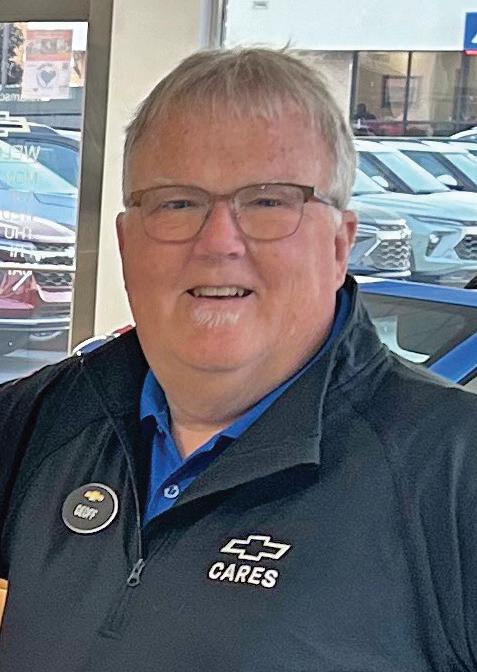

first points of contact for the region’s entrepreneurs and founders seeking assistance on how to start and grow their business. Coate has nearly two decades of experience in early-stage and scaling companies in professional and community development. She also brings first-hand knowledge of entrepreneurship to her role, having co-founded an e-commerce venture.
22 - Stephen Morrison jo ined the organization as community lead. Morrison is the go-to person for current and prospective members, helping people maximize the resources of our coworking space and make new connections. Prior to joining 20Fathoms, he was the taproom manager at Earthen Ales.
23- Annie Zi mmerman moved in to a new role as manager, financial and compliance. Zimmerman supports the chief financial officer with day-to-day finances, as well as grant compliance projects.
Please send Newsmakers by the 10th of the month to news@tcbusinessnews.com

Crisis Intervention Services
• 24/7 Crisis Line 833-295-0616
• Crisis Welcoming Center, 105 Hall Street, Traverse City, 8A-5P, M-F
• Mobile Crisis Teams for Adults and Children
• Coming later in 2024: Grand Traverse Center for Mental Wellness
Kandu Island Drop-In Center – a safe place to be, on S. Garfield.
• Psychiatry
• Therapy
• Counseling
• Case Management
• Autism Applied Behavioral Analysis
• Specialized Residential Services
• Long-term Services and Support
• Traverse House & Club Cadillac Clubhouses

Why is ABC’s Chief Economist wearing a cowboy hat? You guessed it this year ’ s economic forecast is themed The Good, the Bad, and the Ugly, and will supply an in-depth analysis of major factors shaping economic outcomes, including interest rates, global conflict, wage dynamics, business confidence, and demographics It will then turn toward a forecast for the coming year, highlighting the major risks that economic stakeholders will likely encounter
So while Anirban may not be the stoic rugged Clint Eastwood he’ll get you what you need to know on the 2025 economy
Get your tickets here

December 4, 2024
7:30AM - 9:45AM
Hagerty Center
715 E Front Street
Traverse City, MI 49686
Cost: $95/ticket







By Chris Wendel
Most of us are familiar with the writing of Malcom Gladwell. His seminal book “The Tipping Point” explored how hidden patterns in the world we experience work. “Outliers” popularized the notion that it takes 10,000 hours of dedicated work to master an area of expertise. His 2019 book “Talking to Strangers” honed in on how we make judgements of people that can be crucially wrong.
Since the release of “The Tipping Point” in 2000, Gladwell has made an industry out of his unique combination of social research and storytelling. Today, he’s not just a well-known writer, but also a sought-after speaker. His renowned podcast “Revisionist History” places him in rarified air in a medium that didn’t even exist 25 years ago.
To celebrate the release of “The Tipping Point,” almost a quarter century ago, Gladwell first thought he’d write a straightforward retrospective follow-up book. Instead of a nostalgic look back, it didn’t take long for Gladwell to become immersed into a new set of stories that refined his beliefs on what causes unexpected shifts in important events.
The subjects that Gladwell profiles are far reaching and, at first glance, unconnected. We learn about an epidemic of Los Angeles bank robberies that took place in the early 1990s; the strategy involved deploying school-aged kids during their lunch breaks in untraceable stolen cars while the linchpins of the operation safely watched them enter and leave the banks from a few blocks away. Other bank robbers decide that they want a piece of the action when a local news outlet reveals the huge amount being taken in one heist. This is the “tipping point” that is the catalyst for thousands of bank robberies in Los Angeles.
One underlying concept Gladwell explains is what he names the “Magic Third,” which is the view that getting to one-third in a group setting provides a critical mass. His example is the number of women serving on a corporate board. If, for example, a board of nine has only one woman, she will likely feel isolated until there are three or more women serving together on that board. He expands on this concept to tipping point strategies to improve minority students and even residential neighborhoods.
Gladwell also profiles a well-meaning entrepreneur whose move to Miami is the tipping point that turns him into a greedy Medicare rip-off artist. Another Gladwell chapter details a school district in what is considered an ideal American town, but under the shiny veneer lies a serious problem that becomes a suicide epidemic. We also learn why a very small number of dehydrated people became superspreaders during the COVID epidemic.

By Malcolm Gladwell
The major contrast between “The Tipping Point” and “Revenge of the Tipping Point” is that the latest version reveals the way people use rules of epidemics in malicious and devious ways. Gladwell concludes that major upheavals can be tracked to the behavior of a few misguided people, connected circumstances, and specific locations.
Like Gladwell’s recent books, the audio version is a great option for listening to his skillful storytelling. With a technique that I’m surprised is not adopted by more authors, “The Tipping Point Revisited” audio version shines when Gladwell is narrating. And when there are book quotes from other people or characters in the book, he uses either their voices or actors that are tremendously convincing.
If you’re looking for quick takeaway ideas, the somewhat scattered subject matter of the individual sections may appear unsatisfying. One has to be invested as each chapter builds with the next, ultimately reaching the thought-out conclusion Gladwell eventually brings home.
“The Revenge of the Tipping Point” breathes new life into a popular concept and, regardless of any perceived repetitiveness, the book stands on its own as both entertaining and informative.
Chris Wendel works for Northern Initiatives, a mission-based lending organization based in Marquette, Michigan. Northern Initiatives provides funding to businesses throughout Michigan and online business resources through its “Initiate” program to organizations and small business owners throughout the United States. Wendel lives and works in Traverse City.


















